Take Me to the Recipes
Welcome to my exploration of Indonesian cuisine and recipes. Most people know Indonesian cuisine for its diversity, influenced by the country’s vast geography and cultural heritage. From Sumatra to Java, Bali to Sulawesi, each region offers a unique gastronomic experience.
Each generation passes the traditions and rituals of Indonesian food culture to the next. Rice is the staple food and often the centerpiece of a meal, served with a variety of side dishes, including vegetables, meat, and seafood. The use of aromatic spices and herbs in Indonesian cuisine is also prominent, adding depth and complexity to the flavors.
In this article, we’ll explore the most beloved traditional dishes and ingredients used in Indonesian cuisine, as well as popular recipes to try at home and the bustling world of Indonesian street food.
Get ready to embark on a tantalizing journey that will transport you to the vibrant and diverse world of Indonesian cuisine.
Indonesian Cuisine – Key Takeaways:
- Indonesian cuisine is diverse and influenced by the country’s vast geography and cultural heritage.
- Rice is the staple food and often the centerpiece of a meal in Indonesian food culture.
- Chefs use aromatic spices and herbs in Indonesian cuisine to add depth and complexity to the flavors.
- We’ll explore traditional dishes, cooking techniques, ingredients, and popular recipes to try at home.
- The Indonesian Street food scene is a culinary adventure and with hidden gems waiting for you to discover them.
Where is Indonesia?

The Republic of Indonesia (RI), or familiarly known as Indonesia, is a country in Southeast Asia that is located on the equator and situated between the Asian and Australian continents and between the Pacific and Indian Oceans.

Index to the Contents
- Take Me to the Recipes
- More Articles
- Interesting Facts About Indonesia
- Indonesia’s History and the Affect It Has Had on Indonesian Cuisine
- What impact has the climate and geography had on Indonesian Food?
- Understanding the Essence of Indonesian Food
- Exploring Indonesian Food Culture
- Indonesia National Food
- How healthy is Indonesian Food?
- Traditional Indonesian cuisine: Traditional Dishes
- Indonesian Cooking Techniques and Ingredients
- 25 Popular Indonesian Cuisine recipes to Try at Home
- Exploring Indonesian Street Food
- Conclusion
- FAQ’s
You may also be interested in the following articles
- North and South American Cuisine – A Culinary Expedition
- Europe Cuisine: Savor the Continent’s Best Culinary Secrets!
- African Cuisine: Discover the Bold Flavors & Global Charm!
- Asian Cuisine Unlock its Secrets – Taste, Health & Global Influence!
Savor iconic Indonesian Recipes – Click on each tantalizing Image to open up the Recipe
Looking for authentic Indonesian recipes? Look no further! From iconic dishes like nasi goreng to mouthwatering rendang, discover a wide variety of traditional Indonesian recipes that will transport your taste buds to the vibrant streets of Indonesia. Find step-by-step instructions and ingredients for these authentic dishes and enjoy the flavors of Indonesia from the comfort of your own kitchen.
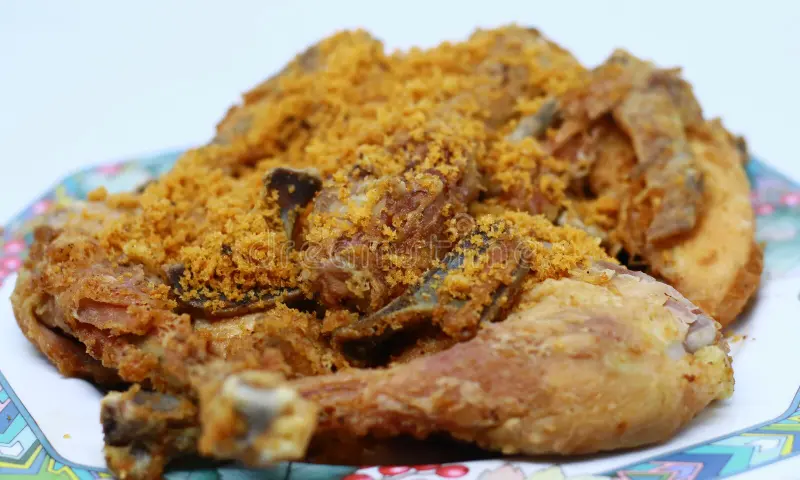

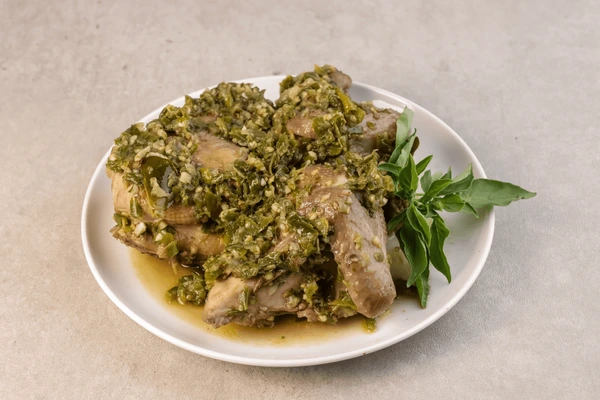
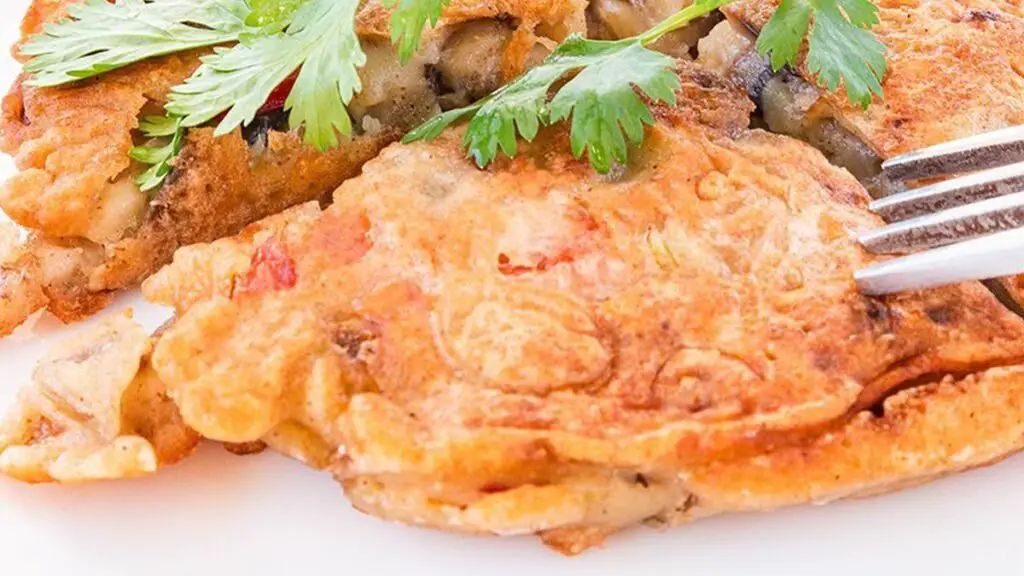
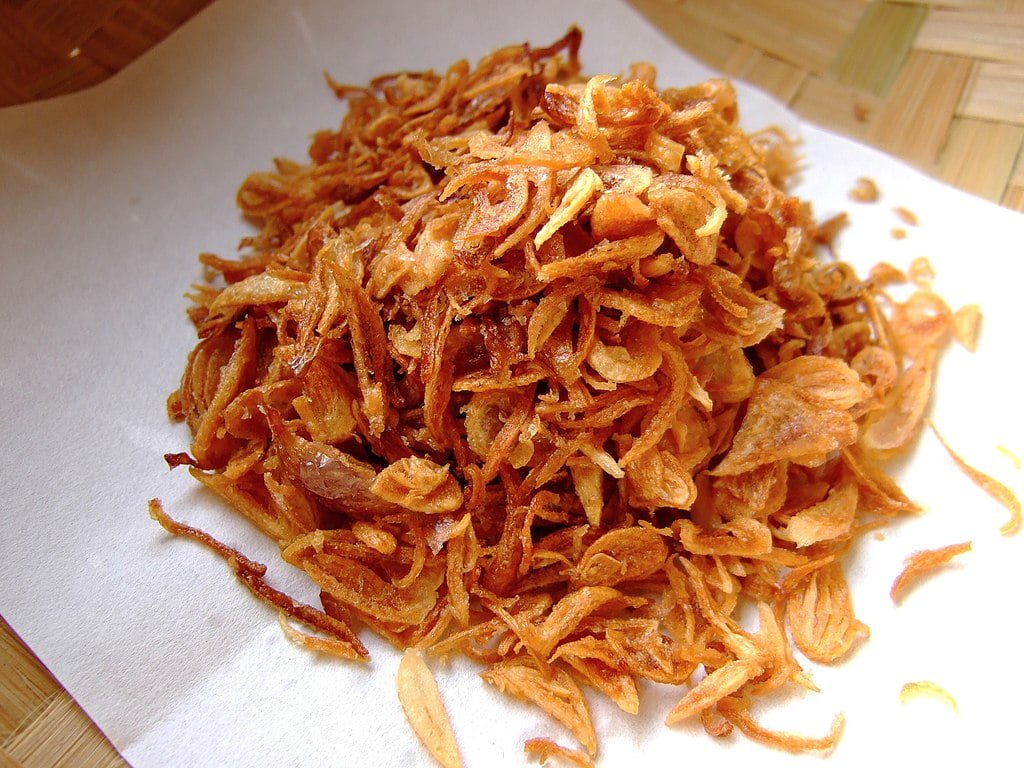
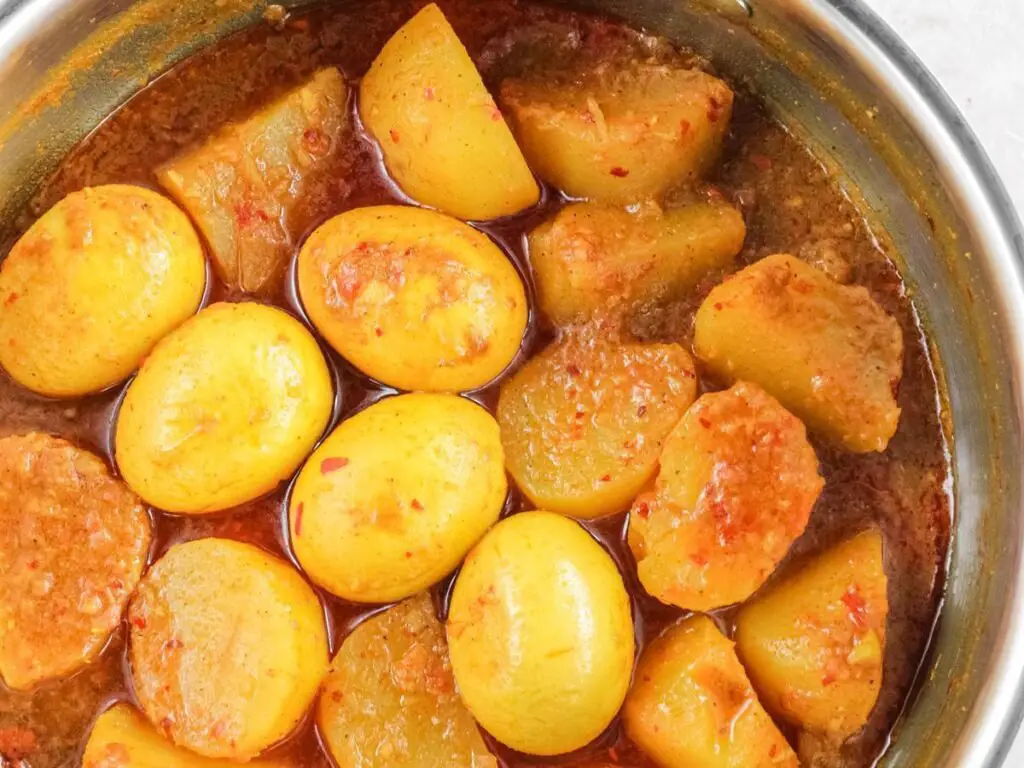


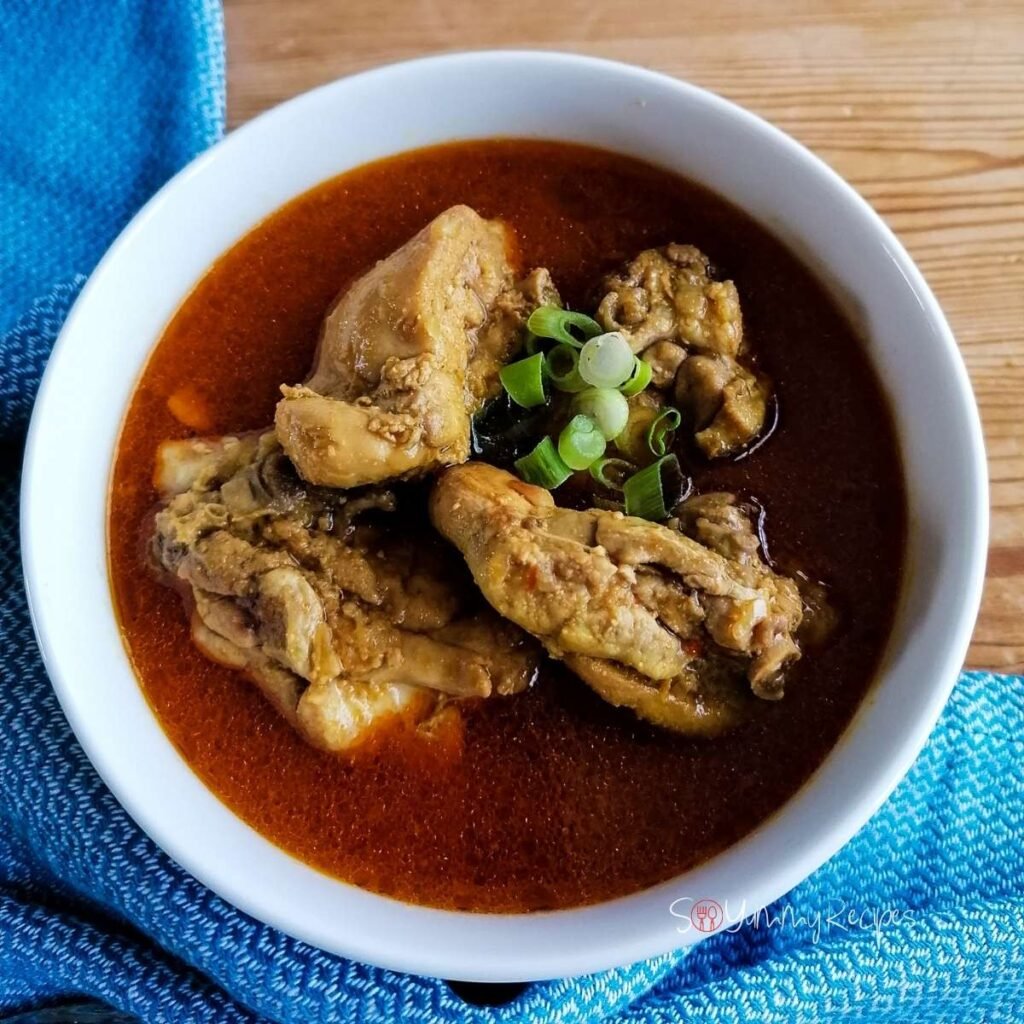

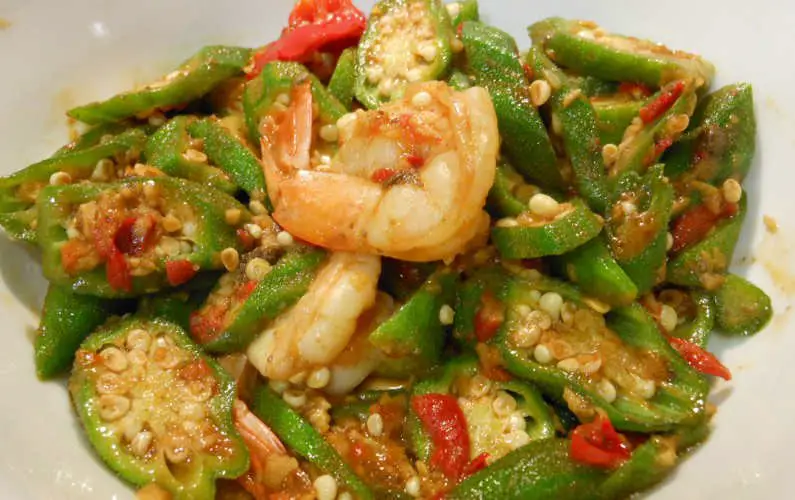
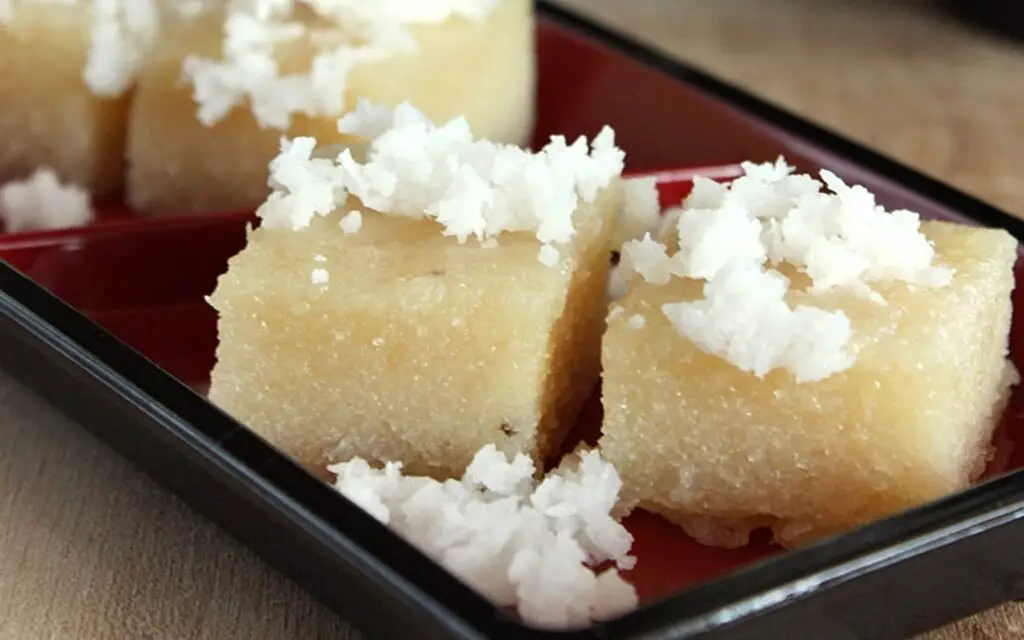




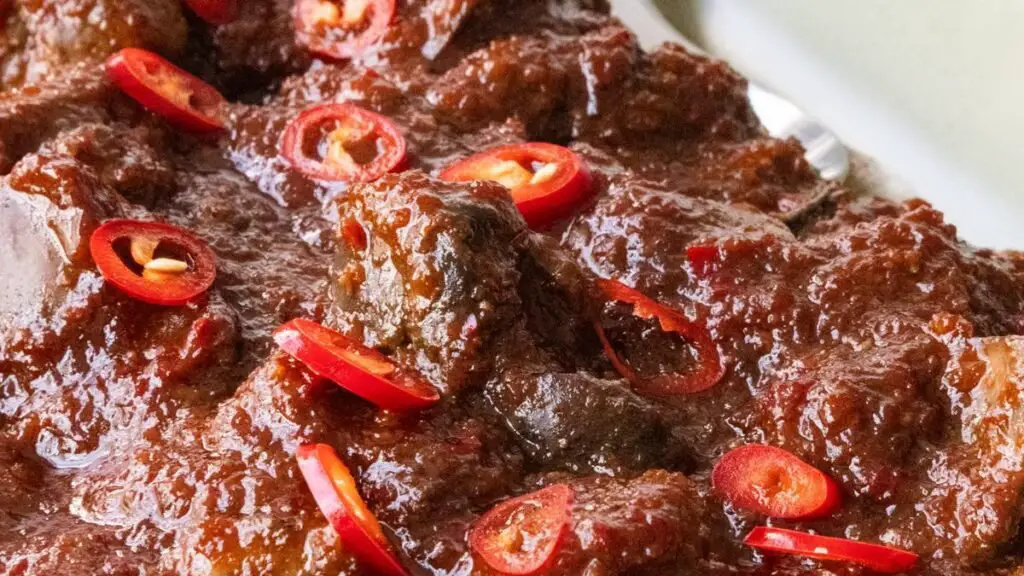
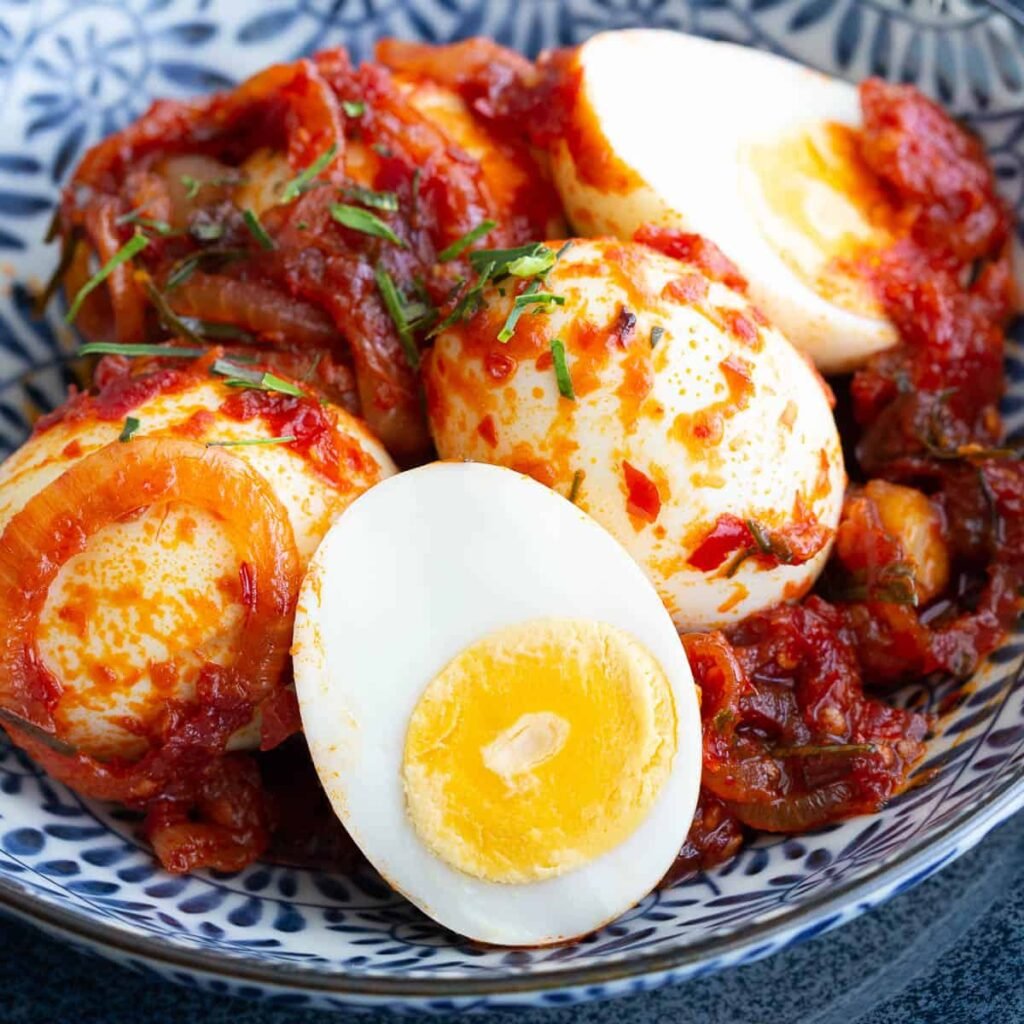



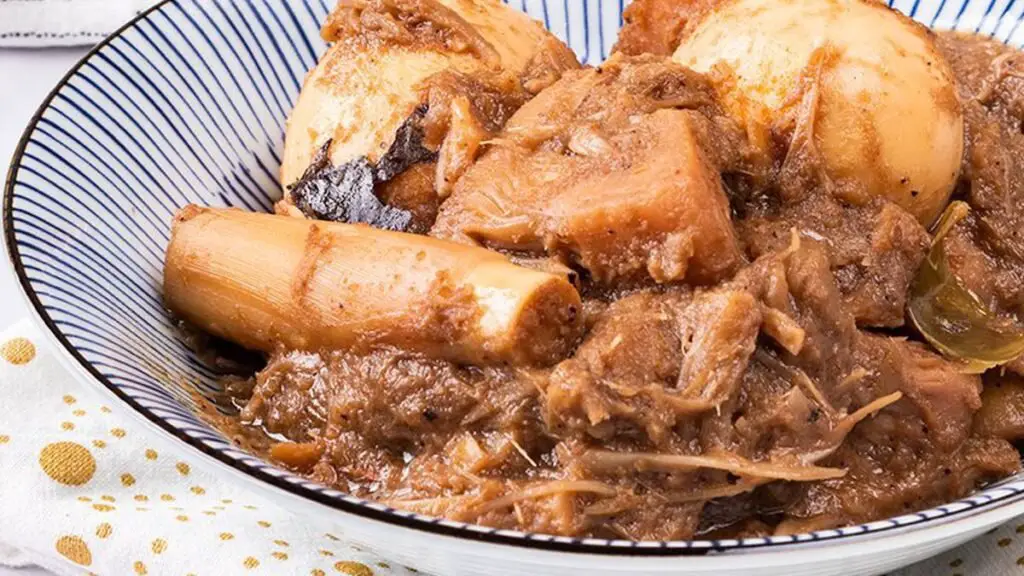

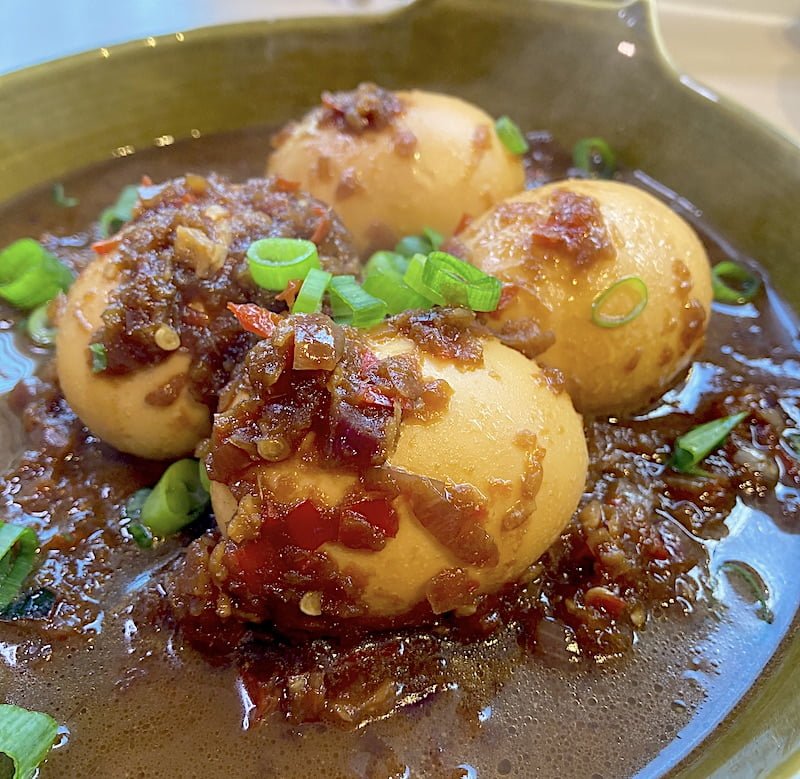

Interesting Facts About Indonesia
Island Paradise

Indonesia is an archipelago comprising over 17,000 islands, making it the world’s largest island country. Each island has its unique cultural nuances, contributing to the nation’s rich diversity.
Volcanic Wonderland

This country is home to around 130 active volcanoes, more than any other nation. One of the most famous, Mount Bromo, is a popular tourist destination known for its otherworldly landscapes.
Deliberate Traffic Jams

In the city of Yogyakarta, there’s a tradition called “Grebeg Maulud,” where massive traffic jams are intentionally created during a religious parade. Locals believe the congestion brings blessings and good fortune.
Orangutans’ Only Home

Indonesia is the only place on Earth where you can find wild orangutans. These critically endangered primates are native to the rainforests of Borneo and Sumatra.
Largest Muslim Population
Indonesia has the world’s largest Muslim population, but it’s known for its religious diversity. The nation embraces various religions, including Islam, Hinduism, Buddhism, and Christianity.
Tribal Longhouses

The Toraja people of Sulawesi build elaborate boat-shaped houses called “tongkonan.” These unique structures, often adorned with buffalo horns, are not only homes but also a symbol of social status.
Ring of Fire

Indonesia is part of the Pacific Ring of Fire, a region known for its high seismic and volcanic activity. Earthquakes are relatively common, and the country experiences thousands of them each year.
Pygmy Elephants

On the island of Sumatra, you can find the Sumatran pygmy elephant, the smallest elephant subspecies. These gentle giants are considered critically endangered.
Cuisine with a Kick
Indonesian cuisine is renowned for its use of spices. The staple chili paste, “sambal,” comes in numerous varieties, showcasing the nation’s love for fiery flavors.
Unusual Independence Day Celebration

To celebrate Indonesia’s Independence Day, citizens participate in various unique competitions, including a “panjat pinang” event where participants climb a greased pole to reach prizes at the top. It’s a fun and challenging tradition!
A Delicious Journey Through Indonesian Food History

Spanning across more than 17,000 islands, Indonesia stands as a testament to cultural diversity and natural abundance. Its storied history, rife with maritime trade, colonization, and the confluence of many civilizations, has profoundly shaped its culinary tapestry.
Imagine Indonesian food as a giant puzzle! Each period in history added a new piece, shaping the delicious mix we know today. Let’s travel back in time and see how spices, religions, and even wars influenced Indonesian cuisine:
Early Explorers (Before 2nd century BCE)
We don’t have complete maps of this time, but we know that people used what they could find: fish, fruits, and whatever grew nearby.
Think of them as the first Indonesian chefs, figuring out how to make tasty meals with simple ingredients.
Spice Traders Arrive (2nd century BCE to 14th century CE)

Hindu and Buddhist travelers brought amazing spices like turmeric, ginger, and coriander. These spices were like magic, adding new flavors and colors to Indonesian dishes.
One example is “rawon,” a dark, yummy beef soup that’s been around for over 1,000 years!
New Beliefs, New Rules (14th to 17th century)
When Islam became more popular, some things changed. People mainly ate rice-based dishes like “nasi goreng” (fried rice) and “soto” (soup) because they fit with Muslim food rules.
These dishes are still super popular today!
Dutch Occupation – The Spice Masters (17th to 20th century)
The Dutch loved spices so much, they controlled the whole trade! They also brought new ingredients like potatoes, cabbage, and carrots. This is where the famous “rijsttafel” comes from – a giant feast with tons of small dishes served with rice.
World War II: Food Fight! (1942–1945)

During the war the Japanese army occupied the Indonesian islands . Finding food was tough.
Indonesians had to get creative, using ingredients like sweet soy sauce to make dishes like “nasi kuning” (yellow rice). It shows how people can make delicious food even when things are hard.
National Revolution (1945–1998)
After gaining independence, Indonesia celebrated its diverse food scene. Different regions shared their specialties, like “rendang” (slow-cooked beef) from Sumatra and “gado-gado” (vegetable salad with peanut sauce) from Java. Yum!
New Order Era (since 1998)

Today, Indonesia welcomes new flavors from all over the world. You can find street food carts, fancy fusion dishes, and everything in between, all alongside traditional recipes. It’s a delicious adventure for anyone who loves to eat!
References
- Wikipedia: Indonesian Cuisine
- BINUS Square Student Committee: History of Indonesian Cuisine
- flavorfulfeas.com
- theculturetrip.com
What impact has the climate and geography had on Indonesian Food?

Indonesia’s unique geography, coupled with a tropical climate, has played a fundamental role in shaping the vibrant tapestry of Indonesian cuisine.
Spice Trail Symphony
Indonesia’s strategic location along ancient trade routes made it a hub for the spice trade. Spices like turmeric, ginger, cloves, and nutmeg not only added layers of flavor and aroma but also acted as natural preservatives in the hot, humid climate.
Think of the fiery rendang from Sumatra, where the abundance of chilies reflects the region’s volcanic soil and proximity to trade routes.
(Source: https://www.seriouseats.com/indonesian-essential-ingredients)
Island Treasures
Indonesia’s vast coastline and numerous islands provide an abundance of seafood. Dishes like ikan bakar (grilled fish) and gulai ikan (fish curry) are staples across the archipelago, reflecting the reliance on these maritime resources.
Variations in fish and cooking methods showcase the ingenuity of coastal communities adapting to local ingredients and traditions.
(Source: https://www.thespruceeats.com/)
Rice, the Humble Hero
From the lush paddy fields of Java to the terraced hills of Bali, rice reigns supreme as the Indonesian staple. The climate, with its abundant rainfall and fertile soil, favors rice cultivation, making it a reliable source of sustenance.
Dishes like nasi goreng (fried rice) and nasi campur (mixed rice) showcase the versatility of rice and its central role in Indonesian cuisine.
(Source: https://blog.epicurina.com/2010/03/nasi-pulen.html)
Fruits of the Land
Tropical fruits like mangosteen, durian, and rambutan thrive in the Indonesian climate, adding refreshing notes and vibrant colors to desserts and snacks.
Local vegetables like kangkung (water spinach) and terong (eggplant) contribute their unique flavors and textures to dishes, reflecting the diversity of agricultural produce across the islands.
(Source: https://www.ajourneybespoke.com/journey/food/tropical-fruits-of-indonesia)
Regional Rhythms
The varied topography and microclimates across Indonesia have fostered distinct regional cuisines. The mountainous regions of Sumatra favor heartier dishes like rendang, while the coastal areas of Sulawesi excel in seafood specialties.
This diversity highlights the deep connection between geography and local culinary traditions.
(Source: https://www.thoughtco.com/geography-of-indonesia-1435052)
Exploring Indonesian Food Culture

As I continue my journey through Indonesian cuisine, the deeply ingrained and diverse food culture of Indonesians fascinates me. Mealtime rituals and traditions are an important part of Indonesian food culture, and I am excited to share some of what I have learned with you.
One of the most important aspects of Indonesian food culture is the use of rice. Indonesians consume rice multiple times a day, and it is often the centerpiece of a meal. The traditional way of cooking rice in Indonesia is by using a steamer, which results in fluffy and perfectly cooked rice. Indonesians serve rice in a unique cone shape, known as “nasi tumpeng.” They typical reserve thus for special occasions and celebrations.
Generation after generation passes the dishes to the next and have made it an essential part of the country’s culinary heritage. Indonesians and food enthusiasts alike love the wide selection of spicy and flavorful selection of recipes.
These include Rendang to the famous nasi goreng (fried rice), and other traditional Indonesian dishes.
Understanding the Essence of Indonesian Food

Indonesian cuisine, a rich tapestry of flavors, is a harmonious blend of diverse culinary traditions shaped by the nation’s geography, history, and cultural influences. Situated at the crossroads of trade routes, Indonesia has been a melting pot of spices, herbs, and cooking techniques for centuries.
Archipelago of Flavor
Indonesia, comprising over 17,000 islands, boasts a staggering variety of dishes. Each region has its specialties, creating a mosaic of taste experiences. From the fiery rendang of Sumatra to the vibrant flavors of Bali’s bebek betutu, Indonesian cuisine is a celebration of diversity.
The Spice Islands’ Legacy
Centuries ago, Indonesia’s Spice Islands were the epicenter of the spice trade, introducing nutmeg, clove, and pepper to the world. Today, these spices remain at the heart of Indonesian cooking, infusing dishes with warmth and complexity.
Rice, the Staple Grain

Rice is the cornerstone of Indonesian meals, serving as the canvas for a myriad of dishes. Nasi Goreng, the beloved fried rice, showcases the creativity in turning a staple into a culinary masterpiece.
Sambal, the Soulful Heat
No exploration of Indonesian food is complete without sambal. This fiery chili condiment, crafted with variations across the archipelago, adds a punch to every bite. Be it sambal terasi or sambal matah, the intensity of flavor elevates Indonesian cuisine.
Satay, Skewers of Delight
Satay, marinated and grilled skewers often served with peanut sauce, exemplify the perfect marriage of sweet, savory, and smoky notes. These street food delights are a testament to Indonesia’s love for communal, flavorful eating.
Indonesian Hospitality
Food in Indonesia is more than sustenance; it is a symbol of hospitality and togetherness. A traditional Indonesian meal is a communal affair, fostering connections and shared moments.
Indonesia National Food

The Indonesia national food, also known as nasi goreng, is a popular dish enjoyed by locals and tourists alike. This flavorful fried rice dish is filled with a combination of spices, vegetables, and protein, often including shrimp, chicken, or tofu.
The dish is typically garnished with a fried egg on top, and served with a side of krupuk, or Indonesian crackers. Nasi goreng is beloved for its aromatic flavors and diverse ingredients, making it a staple in Indonesian cuisine.
How healthy is Indonesian Food?

Indonesian cuisine, with its vibrant flavors and diverse ingredients, offers both health benefits and culinary delights. Let’s explore how local Indonesian foods contribute to well-being:
Rich Biodiversity
Indonesia’s food diversity is astounding. The country boasts over 100 types of carbohydrates, 100 legumes, 450 fruits, and 250 vegetables and mushrooms. This variety ensures a wide range of nutrients.
Insects as Future Food

Some Indonesians incorporate insects into their diet. These tiny creatures are packed with protein and micronutrients. Scientists worldwide are studying insects as a low-carbon animal source food.
Marine Bounty
Indonesia’s seascapes harbor the largest marine biodiversity globally, with nearly 3,000 species found in markets. Fish from warm tropical seas are rich in calcium, iron, and zinc.
Local Staples
Traditional dishes like Sayur Asam (vegetable sour soup) and oxtail soup offer health benefits. Sayur Asam combines various vegetables, tamarind, and spices, providing vitamins and antioxidants.
Nutritionally Enhanced Crops
Indonesia has made strides in developing nutritionally enhanced food crops. These crops contribute to global health by providing essential nutrients.
Traditional Medicinal Recipes:
Indonesian culture also embraces traditional medicine. From fever cures to weight-loss potions, these recipes utilize local herbs and spices for health benefits.
In summary, Indonesian cuisine’s local foods offer a path to healthier and more sustainable diets. By celebrating biodiversity, incorporating insects, and savoring traditional dishes, Indonesians can nourish themselves while respecting the environment.
References
- The Conversation: How Eating a Local Diet Can Help Indonesians Live Healthier and More Sustainable Lives
- Asia Society: Healthy Food of Asia Part 1: Indonesian Cuisine
- AIP Advances: Nutritionally Enhanced Food Crops for Their Potential Health Benefits
- The Culture Trip: 10 Traditional Indonesian Medicine Recipes With Real Health Benefits
Traditional Indonesian cuisine: Traditional Dishes
Traditional Indonesian cuisine: offers a diverse range of traditional dishes that are sure to tantalize your taste buds. Let’s explore some of the most beloved and authentic Indonesian dishes that you can try at home.
Traditional Indonesian Food: – Nasi Goreng

Nasi Goreng, which translates to “fried rice,” is a staple in Indonesian households. Chefs make this dish by stir-frying leftover rice with a combination of diced vegetables, meat or seafood, and spices such as shallots, garlic, and chili. Nasi Goreng is often served with a fried egg on top, making it a delicious and filling meal.
Traditional Indonesian Food: – Rendang
Rendang is a spicy beef stew that originated in the Minangkabau region of Indonesia. Cooks prepare the dish by slow-cooking beef in a mixture of coconut milk and spices, which include galangal, lemongrass, turmeric, and chili. The beef becomes tender, and the sauce thickens as the liquid evaporates. This creates a rich and flavorful dish that they serve with steamed rice.
Traditional Indonesian Food: – Sate
Restaurants often serve Sate, or satay, which is also a popular Indonesian street food. Chefs use skewer meat marinated in a mixture of soy sauce, ginger, and other spices. They then grill it over an open flame. Chefs use chicken, beef, or lamb as the foundation of Sate. They often serve it with a spicy peanut sauce for dipping.
These dishes are just a few examples of the authentic and traditional Indonesian cuisine that you can experience. Be sure to explore the diverse range of flavors that make up Indonesia’s rich culinary heritage.
Indonesian Cooking Techniques and Ingredients

One of the overarching impressions that I have of Indonesian it its bold and flavorful dishes that are a feast for the senses. A major part of the unique taste of Indonesian food comes from its traditional cooking techniques and the use of an array of aromatic spices and ingredients. Let’s take a closer look at the techniques and ingredients that make Indonesian cuisine so special.
Traditional Indonesian Food: Cooking Techniques
One of the most distinctive features of Indonesian cuisine is the use of a mortar and pestle to create vibrant pastes from spices, herbs, and other ingredients. They traditionally use a tool to grind together ingredients like turmeric, coriander, and galangal to create a base for many Indonesian dishes.
Another popular cooking technique in Indonesian cuisine is grilling. Whether it’s meat, fish, or vegetables, Indonesians love to grill their food, resulting in a smoky and charred flavor that is irresistible.
Stir-frying is also a common cooking technique in Indonesian cuisine. It involves cooking ingredients in a wok over high heat to create a quick and flavorful meal.
Traditional Indonesian Food: – Spices and Ingredients
Indonesian cuisine is famous for its use of aromatic spices and ingredients that add a punch of flavor to every dish. Some of the most commonly used spices in Indonesian cuisine include:
- Turmeric: This bright yellow spice is a staple in Indonesian cuisine, used to add color and flavor to dishes like Nasi Goreng and Sate Ayam.
- Lemongrass: With its tangy and citrusy flavor, lemongrass is a popular ingredient in Indonesian soups and curries.
- Coriander: Coriander adds a fragrant and slightly sweet flavor to dishes.
In addition to spices, coconut milk is a common ingredient in Indonesian cuisine, adding a creamy and slightly sweet flavor to dishes like Rendang and Gado-Gado.
Overall, Indonesian cooking techniques and ingredients work together to create a unique and delicious culinary experience that is sure to excite your taste buds.
Popular Indonesian Cuisine recipes to Try at Home
Now that we have explored the diverse and authentic world of Indonesian cuisine, why not try your hand at cooking some of these delicious dishes for yourself? Here are 25 popular Indonesian recipes that are easy to recreate in your own kitchen.
Indonesian recipes – Sambal Goreng Hati (Liver with Chili Sauce)

History and Background:
Indonesia, with its diverse culinary heritage, offers a fiery dish known as Sambal Goreng Hati. This dish originates from the heart of Indonesian home cooking, where bold flavors and aromatic spices are celebrated. Sambal Goreng Hati showcases the country’s love for spicy and rich dishes, often enjoyed with rice. The dish has historical roots in Indonesian homes, where families gather to enjoy the warmth of home-cooked meals.
Indonesian recipes – Sambal Goreng Hati Ingredients
- 500g beef or chicken liver, sliced
- 2 cups coconut milk
- 4 tablespoons vegetable oil
- 3 shallots, finely chopped
- 3 cloves garlic, minced
- 2 red chilies, sliced
- 2 green chilies, sliced
- 2 kaffir lime leaves
- 1 lemongrass stalk, bruised
- 1 teaspoon tamarind paste
- 1 teaspoon palm sugar
- Salt to taste
Indonesian recipes – Sambal Goreng Hati Recipe
Prep the Liver
- Clean and slice the beef or chicken liver into bite-sized pieces.
Make the Spice Paste
- In a blender, combine shallots, garlic, red chilies, and green chilies. Blend until it forms a smooth paste.
Sauté the Spice Paste
- Heat vegetable oil in a pan over medium heat. Sauté the spice paste until fragrant.
Add Aromatics
- Add kaffir lime leaves, lemongrass, and tamarind paste to the pan. Stir well to combine.
Cook the Liver
- Add the sliced liver to the pan and cook until it changes color.
Pour Coconut Milk
- Pour in coconut milk and stir. Let it simmer until the liver is fully cooked.
Season
- Season the dish with palm sugar and salt. Adjust according to taste.
Simmer
- Let the Sambal Goreng Hati simmer on low heat for an additional 10 minutes, allowing the flavors to meld.
Serve
- Once cooked, remove from heat. Serve the Sambal Goreng Hati hot over a bed of steamed rice.
Serving Size:
This recipe serves 4 people.
Estimated Cooking Time:
Approximately 30 minutes.
Nutritional Information (per serving):
- Calories: 350 kcal
- Protein: 15g
- Fat: 25g
- Carbohydrates: 15g
- Fiber: 2g
Enjoy this spicy and savory Indonesian delight that captures the essence of the nation’s culinary traditions!
Indonesian recipes – Okra and Shrimp Stir (Fry with Chili Sauce)

History and Background:
Embark on a flavorful journey with an Indonesian classic, the Okra and Shrimp Stir-Fry with Chili Sauce. Hailing from the vibrant Indonesian archipelago, this dish represents the amalgamation of diverse regional flavors. Indonesia, with its rich culinary history, is known for blending fresh, locally sourced ingredients with aromatic spices.
The Okra and Shrimp Stir-Fry showcases the country’s love for seafood and the perfect balance of sweet, savory, and spicy notes.
Indonesian recipes – Okra and Shrimp Stir Ingredients
- 250g fresh okra, sliced
- 200g shrimp, peeled and deveined
- 2 tablespoons vegetable oil
- 3 cloves garlic, minced
- 2 red chilies, sliced
- 1 onion, thinly sliced
- 1 red bell pepper, julienned
- 2 tablespoons sweet soy sauce
- 1 tablespoon oyster sauce
- 1 tablespoon chili sauce
- Salt and pepper to taste
- Fresh cilantro for garnish
Indonesian recipes – Okra and Shrimp Stir Recipe
Prep the Ingredients
- Slice the fresh okra, mince the garlic, and prepare the shrimp, onion, and red bell pepper.
Heat the Pan
- Heat vegetable oil in a pan over medium-high heat.
Sauté Garlic and Chilies
- Add minced garlic and sliced red chilies to the pan. Sauté until fragrant.
Add Shrimp
- Add the peeled and deveined shrimp to the pan. Cook until they turn pink and opaque.
Toss in Vegetables
- Toss in sliced onions, julienned red bell pepper, and fresh okra. Stir-fry until vegetables are tender-crisp.
Add Sauces
- Pour sweet soy sauce, oyster sauce, and chili sauce over the stir-fry. Mix well.
Season
- Season with salt and pepper to taste. Adjust the spiciness based on preference.
Garnish and Serve
- Garnish with fresh cilantro. Serve the Okra and Shrimp Stir-Fry over steamed rice.
Serving Size:
This recipe serves 3-4 people.
Estimated Cooking Time:
Approximately 20 minutes.
Nutritional Information (per serving):
- Calories: 220 kcal
- Protein: 15g
- Fat: 10g
- Carbohydrates: 18g
- Fiber: 4g
Indulge in the enticing blend of textures and flavors that make this Indonesian dish a delightful addition to your culinary repertoire!
Indonesian recipes – Telur Bumbu Bali (Eggs in Balinese Sauce)

History and Background:
Embark on a culinary adventure with Telur Bumbu Bali, a delectable Indonesian dish that originates from the beautiful island of Bali. Known for its vibrant culture and diverse cuisine, Bali has inspired dishes that blend aromatic spices, coconut, and fresh ingredients.
Telur Bumbu Bali, or Eggs in Balinese Sauce, captures the essence of Balinese cooking with its rich, flavorful sauce and the warmth of the island’s hospitality.
Indonesian recipes – Telur Bumbu Bali Ingredients:
- 6 hard-boiled eggs, peeled
- 2 tablespoons vegetable oil
- 1 onion, finely chopped
- 3 cloves garlic, minced
- 2 red chilies, sliced
- 2 tomatoes, diced
- 1 stalk lemongrass, bruised
- 1 teaspoon shrimp paste (optional)
- 1 teaspoon tamarind paste
- 1 teaspoon palm sugar
- 200ml coconut milk
- Salt to taste
- Fresh cilantro for garnish
Indonesian recipes – Telur Bumbu Bali Recipe:
Prep the Ingredients
- Hard-boil the eggs, peel, and set aside. Chop the onion, mince the garlic, slice the red chilies, and dice the tomatoes.
Sauté Aromatics
- Heat vegetable oil in a pan. Sauté chopped onion, minced garlic, and sliced red chilies until fragrant.
Add Tomatoes and Lemongrass
- Add diced tomatoes and bruised lemongrass to the pan. Cook until tomatoes are soft.
Incorporate Shrimp Paste (Optional)
- If using shrimp paste, add it to the pan. Stir well to combine.
Add Tamarind Paste and Palm Sugar
- Add tamarind paste and palm sugar to the mixture. Stir until palm sugar dissolves.
Pour Coconut Milk
- Pour coconut milk into the pan. Simmer until the sauce thickens.
Add Hard-Boiled Eggs
- Gently add hard-boiled eggs to the sauce. Allow them to soak up the flavors.
Season and Garnish
- Season with salt to taste. Garnish with fresh cilantro.
Serving Size:
This recipe serves 3-4 people.
Estimated Cooking Time:
Approximately 30 minutes.
Nutritional Information (per serving):
- Calories: 280 kcal
- Protein: 12g
- Fat: 20g
- Carbohydrates: 15g
- Fiber: 2g
Savor the enticing blend of spices and the creaminess of coconut milk in this Telur Bumbu Bali recipe, bringing a taste of Bali to your home kitchen!
Indonesian recipes – Ayam Tinoransak (Manado Spicy Braised Chicken)

History and Background:
Dive into the rich culinary tapestry of Indonesia with Ayam Tinoransak, a tantalizing dish that hails from the city of Manado in North Sulawesi. Manado cuisine is celebrated for its bold and fiery flavors, reflecting the vibrant culture of the region.
Ayam Tinoransak, or Manado Spicy Braised Chicken, showcases the unique blend of local spices and herbs, creating a dish that’s both aromatic and full of character.
Indonesian recipes – Ayam Tinoransak Ingredients:
- 1 whole chicken, cut into parts
- 2 tablespoons vegetable oil
- 4 shallots, finely chopped
- 3 cloves garlic, minced
- 2 tomatoes, diced
- 2 lemongrass stalks, bruised
- 4 kaffir lime leaves
- 2 bay leaves
- 3 red chilies, sliced
- 2 green chilies, sliced
- 1 turmeric leaf (optional)
- 1 teaspoon tamarind paste
- Salt and sugar to taste
- 500ml water
Indonesian recipes – Ayam Tinoransak Recipe:
Prep the Chicken
- Clean and cut the whole chicken into parts. Set aside.
Sauté Aromatics
- Heat vegetable oil in a pan. Sauté chopped shallots and minced garlic until fragrant.
Add Chicken and Tomatoes
- Add chicken parts to the pan. Cook until they are browned. Add diced tomatoes and stir well.
Incorporate Lemongrass and Spices
- Add bruised lemongrass, kaffir lime leaves, bay leaves, red chilies, green chilies, and turmeric leaf (if using) to the pan. Stir to combine.
Mix Tamarind Paste
- Dissolve tamarind paste in water and add it to the pan. Mix well.
Braise the Chicken
- Bring the mixture to a boil, then reduce heat and simmer until the chicken is tender and the flavors meld.
Seasoning
- Season with salt and sugar to taste. Adjust according to your preference.
Serve
- Once the chicken is tender and the sauce has thickened, remove from heat. Serve the Ayam Tinoransak with steamed rice.
Serving Size:
This recipe serves 4-5 people.
Estimated Cooking Time:
Approximately 45 minutes.
Nutritional Information (per serving):
- Calories: 380 kcal
- Protein: 25g
- Fat: 15g
- Carbohydrates: 35g
- Fiber: 4g
Experience the bold and spicy flavors of Manado with Ayam Tinoransak, bringing a taste of North Sulawesi to your home kitchen!
Indonesian recipes – Tahu Goreng Bumbu Kuning (Turmeric Fried Tofu)

History and Background:
Embark on a culinary journey to Indonesia with Tahu Goreng Bumbu Kuning, a delightful dish that captures the essence of Indonesian street food. Originating from the vibrant street markets of Jakarta, this recipe showcases the art of incorporating turmeric into everyday dishes.
Turmeric Fried Tofu, or Tahu Goreng Bumbu Kuning, highlights Indonesia’s diverse flavors and the ingenious use of aromatic spices in its cuisine.
Indonesian recipes – Tahu Goreng Bumbu Kuning Ingredients:
- 1 block of firm tofu, sliced into rectangles
- 2 tablespoons turmeric powder
- 2 cloves garlic, minced
- 1 teaspoon coriander powder
- 1 teaspoon salt
- 1 teaspoon sugar
- 1 cup all-purpose flour
- Vegetable oil for frying
- Fresh cilantro leaves for garnish
Indonesian recipes – Tahu Goreng Bumbu Kuning Recipe:
Prepare the Tofu
- Slice the firm tofu into rectangles, ensuring they are well-drained.
Create the Spice Mix
- In a bowl, mix turmeric powder, minced garlic, coriander powder, salt, and sugar to create a spice mix.
Coat Tofu in Spice Mix
- Coat each tofu slice with the spice mix, ensuring an even covering.
Dredge in Flour
- Dredge the spiced tofu slices in all-purpose flour, coating them thoroughly.
Fry the Tofu
- Heat vegetable oil in a pan for frying. Fry the tofu until golden brown and crispy on both sides.
Drain Excess Oil
- Once fried, place the tofu on paper towels to drain excess oil.
Garnish and Serve
- Garnish the Turmeric Fried Tofu with fresh cilantro leaves. Serve it hot and crispy!
Serving Size:
This recipe serves 3-4 people.
Estimated Cooking Time:
Approximately 20 minutes.
Nutritional Information (per serving):
- Calories: 220 kcal
- Protein: 12g
- Fat: 8g
- Carbohydrates: 25g
- Fiber: 3g
Experience the savory and crispy delight of Tahu Goreng Bumbu Kuning, a popular Indonesian street food, right in your own kitchen!
Indonesian recipes – Snake Bean and Egg Stir-Fry

History and Background:
Embark on a culinary adventure to Indonesia with the Snake Bean and Egg Stir-Fry. Hailing from the heart of Indonesian home kitchens, this dish reflects the nation’s rich agricultural landscape and the creative use of locally sourced ingredients.
Snake beans, also known as yardlong beans, are a staple in Indonesian cuisine, celebrated for their crunch and versatility. Paired with eggs and aromatic spices, this stir-fry encapsulates the vibrant and diverse flavors of Indonesian home-cooked meals.
Indonesian recipes – Snake Bean and Egg Stir-Fry Ingredients
- 200g snake beans, cut into bite-sized pieces
- 3 eggs, beaten
- 2 cloves garlic, minced
- 1 red chili, thinly sliced
- 1 tablespoon soy sauce
- 1 tablespoon oyster sauce
- 1 teaspoon sugar
- Salt and pepper to taste
- Cooking oil
- Fresh cilantro leaves for garnish
Indonesian recipes – Snake Bean and Egg Stir-Fry Recipe
Prepare Ingredients
- Cut the snake beans into bite-sized pieces, mince the garlic, and thinly slice the red chili.
Beat Eggs
- In a bowl, beat the eggs and set aside.
Stir-Fry Snake Beans
- Heat cooking oil in a pan. Add minced garlic and sliced chili. Stir-fry until fragrant.
Add Snake Beans
- Add the snake beans to the pan. Cook until they are slightly tender but still crisp.
Pour in Beaten Eggs
- Pour the beaten eggs over the snake beans. Stir gently to combine.
Season
- Add soy sauce, oyster sauce, sugar, salt, and pepper. Continue stirring until the eggs are cooked.
Garnish and Serve
- Garnish the Snake Bean and Egg Stir-Fry with fresh cilantro leaves. Serve it hot over rice or enjoy as a side dish.
Serving Size:
This recipe serves 2-3 people.
Estimated Cooking Time:
Approximately 15 minutes.
Nutritional Information (per serving):
- Calories: 180 kcal
- Protein: 10g
- Fat: 10g
- Carbohydrates: 15g
- Fiber: 5g
Transport your taste buds to Indonesia with this quick and flavorful Snake Bean and Egg Stir-Fry, a dish that perfectly captures the essence of Indonesian home cooking.
Indonesian recipes – Gulai Nangka (Jackfruit Curry)

History and Background:
Embark on a flavorful journey to Indonesia with Gulai Nangka, a delightful Jackfruit Curry that reflects the country’s diverse culinary heritage. Originating from West Sumatra, this dish showcases the vibrant spices and bold flavors synonymous with Indonesian cooking.
Jackfruit, a tropical fruit celebrated for its meaty texture, takes center stage in this curry, creating a satisfying and aromatic experience that captures the essence of Indonesian home kitchens.
Indonesian recipes – Gulai Nangka Ingredients
- 500g young jackfruit, peeled and cut into bite-sized pieces
- 1 can (400ml) coconut milk
- 2 cups vegetable broth
- 2 lemongrass stalks, bruised
- 4 kaffir lime leaves
- 3 shallots, finely sliced
- 3 cloves garlic, minced
- 2 red chilies, sliced
- 1 tablespoon tamarind paste
- 1 tablespoon palm sugar
- 2 tablespoons cooking oil
- Salt to taste
Indonesian recipes – Gulai Nangka Recipe
Prepare Jackfruit
- Peel the jackfruit and cut it into bite-sized pieces. Rinse thoroughly.
Sauté Aromatics
- In a large pot, heat cooking oil. Sauté shallots, garlic, and red chilies until fragrant.
Add Jackfruit
- Add the prepared jackfruit to the pot. Cook for 5 minutes, stirring occasionally.
Step 4: Pour Coconut Milk
- Pour in coconut milk and vegetable broth. Add lemongrass stalks and kaffir lime leaves. Bring to a gentle boil.
Season
- Stir in tamarind paste, palm sugar, and salt. Simmer over low heat for 20-25 minutes until the jackfruit is tender.
Serve
- Once the curry reaches a rich consistency, remove lemongrass and kaffir lime leaves. Serve the Gulai Nangka over steamed rice.
Serving Size:
This recipe serves 4-6 people.
Estimated Cooking Time:
Approximately 40 minutes.
Nutritional Information (per serving):
- Calories: 320 kcal
- Protein: 3g
- Fat: 22g
- Carbohydrates: 30g
- Fiber: 5g
Delight in the rich and comforting flavors of Gulai Nangka, a Jackfruit Curry that pays homage to Indonesia’s culinary tapestry. A taste of Indonesia in every savory bite!
Indonesian recipes – Telur Pindang

History and Background:
Let’s explore the culinary treasures of Indonesia with Telur Pindang, a traditional dish celebrated for its unique flavors. Hailing from the culturally rich Java region, Telur Pindang is a dish where hard-boiled eggs are infused with a savory and aromatic broth.
This culinary gem represents the heart of Indonesian home cooking, showcasing the country’s love for robust spices and well-balanced tastes.
Indonesian recipes – Telur Pindang Ingredients
- 6 hard-boiled eggs, peeled
- 2 cups water
- 1 cup sweet soy sauce (kecap manis)
- 1 cinnamon stick
- 3 cloves
- 3 cardamom pods
- 1 star anise
- 2 tablespoons palm sugar
- 1 teaspoon salt
- 2 kaffir lime leaves
- 2 tablespoons cooking oil
Indonesian recipes – Telur Pindang Recipe
Boil Eggs
- Boil the eggs until they are hard-boiled. Once done, peel them and set aside.
Prepare Aromatic Broth
- In a pot, heat cooking oil. Add cinnamon stick, cloves, cardamom pods, and star anise. Sauté until fragrant.
Step 3: Add Water and Sweet Soy Sauce
- Pour water and sweet soy sauce into the pot. Stir well.
Infuse Flavors
- Add palm sugar, salt, and kaffir lime leaves. Simmer over low heat for 15-20 minutes to allow flavors to meld.
Add Hard-Boiled Eggs
- Gently place hard-boiled eggs into the broth. Ensure the eggs are submerged.
Simmer
- Let the eggs simmer in the flavorful broth for an additional 15-20 minutes, absorbing the rich taste.
Serve
- Once the eggs have absorbed the flavors, remove them from the pot. Serve the Telur Pindang warm, allowing the infused eggs to tantalize your taste buds.
Serving Size:
This recipe serves 3-4 people.
Estimated Cooking Time:
Approximately 45 minutes.
Nutritional Information (per serving):
- Calories: 220 kcal
- Protein: 10g
- Fat: 10g
- Carbohydrates: 20g
- Fiber: 2g
Savor the essence of Java with Telur Pindang, a dish that combines simplicity with extraordinary flavors, bringing a taste of Indonesian tradition to your table!
Indonesian recipes – Braised Eggs

History and Background:
Embark on a culinary journey through Indonesia with a delightful dish known as “Braised Eggs.” Hailing from the vibrant streets of Jakarta, this recipe reflects the diversity of Indonesian cuisine.
Eggs, a staple in many Indonesian homes, are elevated to a new level with a medley of aromatic spices and a rich, savory sauce. The dish captures the essence of Indonesian comfort food, balancing simplicity and bold flavors.
Indonesian recipes – Braised Eggs Ingredients
- 6 large eggs
- 1 large onion, thinly sliced
- 2 cloves garlic, minced
- 1 tomato, diced
- 1 lemongrass stalk, bruised
- 2 kaffir lime leaves
- 1 teaspoon coriander powder
- 1 teaspoon turmeric powder
- 1 teaspoon palm sugar
- 2 tablespoons sweet soy sauce (kecap manis)
- 2 tablespoons cooking oil
- Salt and pepper to taste
- Chopped cilantro for garnish
Indonesian recipes – Braised Eggs Recipe
Boil Eggs
- Boil the eggs until they are hard-boiled. Peel and set them aside.
Sauté Aromatics
- In a pan, heat cooking oil. Sauté onion, garlic, and lemongrass until fragrant.
Add Spices
- Add coriander powder, turmeric powder, and diced tomato. Stir well.
Create Sauce
- Pour sweet soy sauce into the pan. Add palm sugar, kaffir lime leaves, salt, and pepper. Mix until the sugar dissolves.
Add Boiled Eggs
- Carefully place the hard-boiled eggs into the sauce. Ensure they are coated evenly.
Simmer
- Let the eggs simmer in the sauce for 15-20 minutes, allowing them to absorb the flavors.
Garnish and Serve
- Garnish with chopped cilantro. Serve the Braised Eggs over rice, allowing the rich sauce to complement the eggs.
Serving Size:
This recipe serves 3-4 people.
Estimated Cooking Time:
Approximately 30 minutes.
Nutritional Information (per serving):
- Calories: 180 kcal
- Protein: 12g
- Fat: 12g
- Carbohydrates: 6g
- Fiber: 2g
Indulge in the comforting flavors of Jakarta with Braised Eggs, a dish that brings the warmth of Indonesian kitchens to your home.
Indonesian recipes – Sambal Talar (Eggs in Chili Sauce)

History and Background:
Embark on a culinary adventure to the heart of Indonesia with “Sambal Talar,” a fiery delight originating from the bustling streets of Bali. This dish captures the essence of Indonesian cuisine, where bold flavors and aromatic spices take center stage.
Sambal Talar transforms simple eggs into a symphony of tastes, showcasing the rich culinary heritage of the region. Get ready to spice up your kitchen with this tantalizing recipe that reflects the vibrant spirit of Indonesian cooking.
Indonesian recipes – Sambal Talar Ingredients
- 6 hard-boiled eggs, peeled
- 4 shallots, finely chopped
- 3 cloves garlic, minced
- 4 red chili peppers, sliced
- 2 tomatoes, diced
- 2 tablespoons tamarind paste
- 1 tablespoon palm sugar
- 2 tablespoons cooking oil
- 1 teaspoon shrimp paste (optional)
- Salt to taste
- Chopped cilantro for garnish
Indonesian recipes – Sambal Talar Recipes
Prepare Eggs
- Boil the eggs until hard-boiled, peel, and set aside.
Sauté Aromatics
- In a pan, heat cooking oil. Sauté shallots, garlic, and red chili peppers until fragrant.
Add Tomatoes
- Add diced tomatoes to the pan. Cook until they soften.
Create Chili Paste
- Mix tamarind paste, palm sugar, and shrimp paste (if using) in a bowl. Add this mixture to the pan, stirring well.
Simmer
- Allow the sauce to simmer for 10-15 minutes, ensuring it thickens.
Add Eggs
- Gently place the hard-boiled eggs into the sauce, coating them evenly. Let them absorb the flavors for an additional 5 minutes.
Garnish and Serve
- Garnish with chopped cilantro. Serve Sambal Talar over rice or with your favorite side dish.
Serving Size:
This recipe serves 3-4 people.
Estimated Cooking Time:
Approximately 30 minutes.
Nutritional Information (per serving):
- Calories: 210 kcal
- Protein: 12g
- Fat: 14g
- Carbohydrates: 8g
- Fiber: 2g
Transport your taste buds to the lively streets of Bali with Sambal Talar, a dish that brings the vibrant flavors of Indonesia to your dining table.
Indonesian recipes – Orak Arik Buncis & Wortel (Green Bean, Carrot, and Egg Stir Fry)

History and Background:
Embark on a culinary journey to Indonesia with “Orak Arik Buncis & Wortel,” a flavorful stir fry originating from the heart of Indonesian home kitchens. This dish perfectly captures the essence of Indonesian cuisine, where fresh vegetables and aromatic spices are celebrated.
Orak Arik Buncis & Wortel is a delightful combination of green beans, carrots, and eggs, creating a harmonious medley of textures and tastes. Let’s dive into this easy-to-make recipe that brings the authentic flavors of Indonesia to your home.
Indonesian recipes – Orak Arik Buncis & Wortel Ingredients
- 200g green beans, chopped
- 2 carrots, julienned
- 4 eggs, beaten
- 1 onion, thinly sliced
- 2 cloves garlic, minced
- 2 tablespoons soy sauce
- 1 teaspoon oyster sauce
- 1 teaspoon sesame oil
- 2 tablespoons cooking oil
- Salt and pepper to taste
- Chopped green onions for garnish
Indonesian recipes – Orak Arik Buncis & Wortel Recipe
Prepare Vegetables
- Chop green beans and julienne carrots. Set aside.
Sauté Aromatics
- Heat cooking oil in a pan. Sauté onions and garlic until fragrant.
Add Vegetables
- Add green beans and carrots to the pan. Stir-fry until they are slightly tender but still crisp.
Cook Eggs
- Push the vegetables to the side of the pan. Pour beaten eggs into the empty side. Scramble the eggs until fully cooked.
Combine and Season
- Mix the cooked eggs with the vegetables. Add soy sauce, oyster sauce, sesame oil, salt, and pepper. Stir well.
Garnish and Serve
- Garnish with chopped green onions. Serve Orak Arik Buncis & Wortel with steamed rice.
Serving Size:
This recipe serves 2-3 people.
Estimated Cooking Time:
Approximately 20 minutes.
Nutritional Information (per serving):
- Calories: 280 kcal
- Protein: 13g
- Fat: 18g
- Carbohydrates: 20g
- Fiber: 6g
Bring the flavors of Indonesia to your table with Orak Arik Buncis & Wortel, a simple yet delicious stir fry that showcases the vibrant and diverse Indonesian culinary traditions.
Indonesian recipes – Puding Agar Gula Merah (Palm Sugar Agar Pudding)

History and Background:
Dive into the rich and sweet world of Indonesian desserts with “Puding Agar Gula Merah,” a delightful Palm Sugar Agar Pudding. This dessert reflects the cultural tapestry of Indonesia, where palm sugar, or gula merah, is a cherished ingredient.
Known for its earthy sweetness, this pudding offers a tantalizing blend of flavors that will transport you to the vibrant streets and warm kitchens of Indonesia.
Indonesian recipes – Puding Agar Gula Merah Ingredients
- 100g palm sugar, grated
- 10g agar-agar powder
- 500ml water
- 200ml coconut milk
- A pinch of salt
- Ice cubes (optional)
- Fresh fruits for garnish
Indonesian recipes – Puding Agar Gula Merah Recipe
Prepare Palm Sugar Syrup
- In a saucepan, dissolve grated palm sugar in 200ml of water over medium heat. Strain to remove impurities. Set aside.
Prepare Agar Mixture
- In a separate bowl, dissolve agar-agar powder in 300ml of water. Let it sit for 5 minutes.
Cook Agar Mixture
- Heat the agar mixture over medium heat until it comes to a gentle boil. Stir continuously.
Add Coconut Milk
- Pour in coconut milk and a pinch of salt. Stir well and let it simmer for 2-3 minutes.
Combine Syrup and Agar Mixture
- Slowly pour the palm sugar syrup into the agar mixture. Stir continuously until well combined.
Pour into Mold
- Remove from heat and pour the mixture into molds or serving glasses. Allow it to cool slightly.
Chill and Garnish
- Refrigerate the pudding for at least 2 hours or until set. Optionally, serve with ice cubes and garnish with fresh fruits.
Serving Size:
This recipe makes 4 servings.
Estimated Cooking Time:
Approximately 20 minutes, plus chilling time.
Nutritional Information (per serving):
- Calories: 180 kcal
- Protein: 1g
- Fat: 7g
- Carbohydrates: 30g
- Fiber: 1g
Indulge in the sweetness of Indonesian culture with Puding Agar Gula Merah, a dessert that captures the essence of tradition and flavor in every delightful bite.
Indonesian recipes – Ayam dan Tahu Bacem (Javanese Deep-Fried Chicken and Tofu)

History and Background:
Embark on a culinary journey to the heart of Java with “Ayam dan Tahu Bacem,” a classic Javanese dish that showcases the region’s flavorful traditions. This recipe pays homage to the art of deep-frying, a cooking method deeply embedded in Javanese cuisine.
The marriage of tender chicken and tofu, bathed in a sweet and savory marinade, reflects the diverse and aromatic tastes of Indonesia.
Indonesian recipes – Ayam dan Tahu Bacem Ingredients
- 500g chicken, cut into pieces
- 250g firm tofu, sliced
- 2 bay leaves
- 2 kaffir lime leaves
- Cooking oil (for deep-frying)
Indonesian recipes – Ayam dan Tahu Bacem Marinade
- 3 tablespoons sweet soy sauce
- 2 tablespoons palm sugar, grated
- 1 teaspoon coriander powder
- 1 teaspoon turmeric powder
- 2 cloves garlic, minced
- 1 teaspoon salt
- 500ml water
Recipe:
Prepare Marinade
- In a bowl, combine sweet soy sauce, grated palm sugar, coriander powder, turmeric powder, minced garlic, and salt. Mix well.
Marinate Chicken and Tofu
- Place chicken and tofu in a large bowl. Pour the marinade over them, ensuring all pieces are well coated. Let it marinate for at least 1 hour.
Deep-Fry Chicken and Tofu
- Heat cooking oil in a deep pan. Fry marinated chicken and tofu until golden brown and cooked through. Drain on paper towels.
Infuse with Aromatics
- In a separate pan, sauté bay leaves and kaffir lime leaves until fragrant. Add the fried chicken and tofu to infuse flavors.
Simmer in Marinade
- Pour the remaining marinade into the pan. Simmer on low heat until the sauce thickens and coats the chicken and tofu.
Serve
- Transfer to a serving plate and garnish with fresh herbs. Serve with steamed rice.
Serving Size:
This recipe makes 4 servings.
Estimated Cooking Time:
Approximately 1.5 hours (including marinating time).
Nutritional Information (per serving):
- Calories: 380 kcal
- Protein: 30g
- Fat: 15g
- Carbohydrates: 25g
- Fiber: 2g
Indulge in the comforting flavors of Ayam dan Tahu Bacem, a dish that encapsulates the warmth and authenticity of Javanese culinary traditions.
Indonesian recipes – Sate Babi (Indonesian Pork Satay)

History and Background:
Embark on a culinary adventure with “Sate Babi,” a beloved Indonesian dish that elevates the art of grilling to new heights. Hailing from the diverse archipelago of Indonesia, this recipe showcases the rich tapestry of flavors that make Indonesian cuisine a true gem.
The skewered pork, marinated in a symphony of spices, is a testament to the country’s vibrant culinary heritage.
Indonesian recipes – Sate Babi Ingredients
- 500g pork shoulder, cut into cubes
- 20 bamboo skewers, soaked in water
- 2 shallots, finely chopped
- 2 cloves garlic, minced
- 1 teaspoon coriander powder
- 1 teaspoon turmeric powder
- 1 tablespoon sweet soy sauce
- 1 tablespoon honey
- 1 tablespoon vegetable oil
- Salt and pepper to taste
Indonesian recipes – Sate Babi Recipe
Prepare Marinade
- In a bowl, combine chopped shallots, minced garlic, coriander powder, turmeric powder, sweet soy sauce, honey, vegetable oil, salt, and pepper. Mix well.
Marinate Pork
- Place pork cubes in a large bowl. Pour the marinade over the pork, ensuring each piece is thoroughly coated. Marinate for at least 2 hours, or overnight for better flavor.
Skewer the Pork
- Thread marinated pork cubes onto the soaked bamboo skewers.
Grill the Satay
- Preheat a grill or grill pan. Grill the skewers over medium-high heat, turning occasionally, until the pork is cooked through and has a nice char.
Serve
- Arrange the skewers on a plate and serve with steamed rice or peanut sauce.
Serving Size:
This recipe makes 4 servings.
Estimated Cooking Time:
Approximately 20 minutes (excluding marinating time).
Nutritional Information (per serving):
- Calories: 250 kcal
- Protein: 20g
- Fat: 15g
- Carbohydrates: 10g
- Fiber: 1g
Indulge in the smoky and flavorful goodness of Sate Babi, a dish that encapsulates the spirit of Indonesian grilling traditions. Perfect for a cozy family dinner or a festive gathering with friends!
Indonesian recipes – Ongol-Ongol Singkong (Steamed Cassava Cake)

History and Background:
Dive into the sweet world of Indonesian desserts with “Ongol-Ongol Singkong,” a delightful steamed cassava cake. Originating from the tropical paradise of Indonesia, this dessert reflects the country’s passion for incorporating local ingredients into their culinary creations.
Cassava, a starchy root vegetable, takes center stage in this recipe, offering a chewy and fragrant treat that captures the essence of Indonesian home cooking.
Indonesian recipes – Ongol-Ongol Singkong Ingredients
- 2 cups grated cassava
- 1 cup coconut milk
- 1 cup palm sugar, grated
- 1/2 cup water
- 1/2 cup rice flour
- 1/4 teaspoon salt
- Banana leaves for wrapping (optional)
Indonesian recipes – Ongol-Ongol Singkong Recipe
Prepare Cassava Mixture
- In a large bowl, combine grated cassava, coconut milk, and rice flour. Mix well to form a smooth batter.
Make Palm Sugar Syrup
- In a saucepan, dissolve grated palm sugar in water over low heat, stirring until it forms a syrup. Set aside.
Combine Ingredients
- Gradually add the palm sugar syrup to the cassava mixture, stirring continuously. Add salt and mix until well combined.
Steam the Mixture
- If using banana leaves, cut them into squares and briefly pass them over an open flame to make them pliable. Place a spoonful of the cassava mixture in the center of each banana leaf square and fold into parcels.
Steam the Parcels
- Arrange the wrapped cassava parcels in a steamer and steam for approximately 30-40 minutes, or until the cake is firm.
Serve
- Allow the ongol-ongol singkong to cool before serving. Unwrap the banana leaves and enjoy this delightful Indonesian sweet treat.
Serving Size:
This recipe makes 6 servings.
Estimated Cooking Time:
Approximately 40 minutes.
Nutritional Information (per serving):
- Calories: 200 kcal
- Protein: 2g
- Fat: 5g
- Carbohydrates: 40g
- Fiber: 1g
Indulge in the irresistible charm of Ongol-Ongol Singkong, a dessert that brings the flavors of Indonesia straight to your home. Perfect for a cozy afternoon snack or a sweet ending to a family meal!
Indonesian recipes – Kare Ayam Jawa (Javanese Chicken Curry)

History and Background:
Embark on a flavorful journey to Java, Indonesia, with “Kare Ayam Jawa” or Javanese Chicken Curry. This aromatic dish reflects the rich culinary heritage of Java, an island known for its diverse and intricate flavors.
The blend of indigenous spices and influences from various cultures makes Javanese cuisine a unique and delightful experience. Kare Ayam Jawa, with its hearty chicken and fragrant curry, is a comforting dish that captures the essence of Indonesian home cooking.
Indonesian recipes – Kare Ayam Jawa Ingredients
- 1 kg chicken, cut into pieces
- 2 potatoes, peeled and diced
- 400 ml coconut milk
- 2 tomatoes, chopped
- 2 stalks lemongrass, bruised
- 3 kaffir lime leaves
- 2 tablespoons cooking oil
- Salt and sugar to taste
Indonesian recipes – Kare Ayam Jawa Recipe
Prepare Chicken and Potatoes
- In a large pot, heat cooking oil over medium heat. Add chicken pieces and cook until browned.
Add Aromatics
- Add lemongrass, kaffir lime leaves, and tomatoes to the pot. Stir until the tomatoes are soft.
Pour Coconut Milk
- Pour in the coconut milk and bring the mixture to a gentle simmer. Allow the flavors to meld for about 10 minutes.
Add Potatoes
- Introduce the diced potatoes to the pot. Stir well and let the curry simmer until the potatoes are tender.
Season
- Season the curry with salt and sugar according to your taste preferences. Continue simmering until the chicken is cooked through.
Serve
- Once the chicken is tender and the flavors have melded, remove the pot from heat. Serve the Javanese Chicken Curry over steamed rice.
Serving Size:
This recipe serves 4 people.
Estimated Cooking Time:
Approximately 40 minutes.
Nutritional Information (per serving):
- Calories: 450 kcal
- Protein: 25g
- Fat: 30g
- Carbohydrates: 20g
- Fiber: 3g
Transport your taste buds to the heart of Java with this Kare Ayam Jawa. A delicious and comforting dish that’s perfect for bringing a taste of Indonesian tradition to your home kitchen. Enjoy the aromatic blend of spices and the warmth of Javanese hospitality!
Indonesian recipes – Bawang Goreng Microwave (Microwave Fried Shallots)

History and Background:
Embark on a culinary adventure with the simplicity and versatility of “Bawang Goreng Microwave” or Microwave Fried Shallots. In Indonesian cuisine, shallots are a staple ingredient that adds a flavorful crunch to various dishes.
This quick and easy recipe for Microwave Fried Shallots pays homage to the rich tapestry of Indonesian flavors, offering a convenient way to elevate your meals with a touch of aromatic and crispy goodness.
Indonesian recipes – Bawang Goreng Microwave Ingredients:
- 200g shallots, thinly sliced
- Cooking spray or a teaspoon of oil
- Salt to taste
Indonesian recipes – Bawang Goreng Microwave Recipe:
Prepare Shallots
- Peel and thinly slice the shallots. The thinner the slices, the crispier the result.
Microwave
- Place the sliced shallots on a microwave-safe plate, ensuring they are evenly spread out.
Spray or Drizzle Oil
- Lightly spray the shallots with cooking spray or drizzle a teaspoon of oil over them. This helps in achieving that crispy texture.
Microwave in Intervals
- Microwave the shallots in 1-minute intervals, checking and stirring between each interval. Continue until they reach a golden brown color.
Season
- Once the shallots are crispy and golden, remove them from the microwave. Sprinkle with a pinch of salt to enhance the flavor.
Cool and Store
- Allow the Microwave Fried Shallots to cool completely before storing them in an airtight container. They can be stored for future use.
Serving Size:
This recipe yields approximately 1 cup of Microwave Fried Shallots.
Estimated Cooking Time:
Around 5-7 minutes.
Nutritional Information (per serving):
- Calories: 45 kcal
- Fat: 0.5g
- Carbohydrates: 9g
- Fiber: 1g
- Protein: 1g
Experience the convenience and delightful crunch of Microwave Fried Shallots, a versatile addition to salads, soups, and various Indonesian dishes. Elevate your home-cooked meals with this simple yet impactful recipe that captures the essence of Indonesian culinary ingenuity!
Indonesian recipes – Gudeg Jogja (Yogyakarta Jackfruit Stew)

History and Background:
Let’s dive into the heart of Indonesian cuisine with “Gudeg Jogja,” a traditional dish hailing from Yogyakarta. This rich and flavorful jackfruit stew is a celebrated specialty, showcasing the cultural tapestry of Java.
Gudeg Jogja is a slow-cooked masterpiece that marries sweet and savory flavors, offering a taste of the vibrant culinary heritage of Indonesia.
Indonesian recipes – Gudeg Jogja Ingredients:
- 500g young jackfruit, shredded
- 200g chicken, cut into pieces
- 200g palm sugar
- 4 bay leaves
- 1 teaspoon coriander powder
- 1 teaspoon galangal powder
- 1 teaspoon turmeric powder
- 1 liter coconut water
- Salt to taste
- Banana leaves for serving
Indonesian recipes – Gudeg Jogja Recipe:
Prepare Jackfruit
- Shred the young jackfruit, discarding the seeds and the tough core.
Cook Chicken
- In a large pot, cook the chicken pieces until browned.
Add Jackfruit
- Add the shredded jackfruit to the pot and mix well with the chicken.
Spice Infusion
- Introduce coriander powder, galangal powder, and turmeric powder to the mix. Stir to combine.
Sweeten the Pot
- Incorporate palm sugar, bay leaves, and a pinch of salt into the pot.
Coconut Water Bath
- Pour in the coconut water, ensuring the ingredients are submerged. Bring it to a boil.
Simmer to Perfection
- Reduce the heat and simmer for 2-3 hours, allowing the flavors to meld and the stew to thicken.
Banana Leaf Presentation
- Serve Gudeg Jogja on banana leaves for an authentic touch.
Serving Size:
This recipe serves approximately 4 people.
Estimated Cooking Time:
Around 3 hours.
Nutritional Information (per serving):
- Calories: 350 kcal
- Fat: 6g
- Carbohydrates: 70g
- Fiber: 5g
- Protein: 15g
Immerse yourself in the cultural journey of Gudeg Jogja, where the enchanting blend of jackfruit, chicken, and aromatic spices creates a symphony of flavors that reflects the soul of Yogyakarta’s culinary tradition. Share this delightful dish with loved ones for a taste of Indonesia’s rich heritage.
Indonesian recipes – Pandan Chiffon Cake

History and Background:
Embark on a delightful journey to the heart of Indonesian dessert with the Pandan Chiffon Cake. This soft, spongy delicacy is a beloved treat, with roots deeply embedded in Indonesian culinary culture.
Pandan leaves, known for their sweet aroma and vibrant green color, impart a unique flavor to this cake, making it a cherished and culturally significant dessert in Indonesian households.
Indonesian recipes – Pandan Chiffon Cake Ingredients:
- 2 cups all-purpose flour
- 1 cup granulated sugar
- 1 tablespoon baking powder
- 1/2 teaspoon salt
- 1/2 cup vegetable oil
- 1/2 cup coconut milk
- 1/2 cup pandan juice (extracted from pandan leaves)
- 1 teaspoon pandan paste
- 6 large eggs, separated
- 1/2 teaspoon cream of tartar
Indonesian recipes – Pandan Chiffon Cake Recipe:
Prepare the Batter
- Preheat the oven to 325°F (163°C). Grease and flour a chiffon cake pan.
- In a large bowl, whisk together flour, sugar, baking powder, and salt.
Create a Well
- Make a well in the center of the dry ingredients and add oil, coconut milk, pandan juice, pandan paste, and egg yolks. Mix until smooth.
Whip Egg Whites
- In a separate bowl, beat egg whites and cream of tartar until stiff peaks form.
Combine Mixtures
- Gently fold the egg white mixture into the batter until fully combined.
Bake
- Pour the batter into the prepared pan and bake for 50-60 minutes or until a toothpick inserted comes out clean.
Cool and Invert
- Allow the cake to cool upside down by placing the pan on a bottle to maintain its fluffiness.
Serve
- Once cooled, gently run a knife around the edges and invert the cake onto a plate.
Serving Size:
This recipe yields a delightful Pandan Chiffon Cake that serves approximately 8 people.
Estimated Cooking Time:
Around 1 hour.
Nutritional Information (per serving):
- Calories: 280 kcal
- Fat: 12g
- Carbohydrates: 38g
- Protein: 5g
Indulge in the heavenly Pandan Chiffon Cake, a dessert that captures the essence of Indonesia’s sweet culinary traditions. Share this light and airy treat with friends and family, savoring the unique flavor of pandan that elevates this cake to a cultural masterpiece.
Indonesian recipes – Bakwan Jamur (Mushroom Fritters)

History and Background:
Dive into the delightful world of Indonesian street food with Bakwan Jamur, delicious mushroom fritters that showcase the country’s diverse culinary tapestry. Originating from the bustling street markets of Indonesia, these fritters are a popular snack loved for their crispy exterior and savory, umami-packed filling.
This recipe perfectly embodies the spirit of Indonesian street food culture.
Indonesian recipes – Bakwan Jamur Ingredients:
- 200g button mushrooms, finely chopped
- 1 cup all-purpose flour
- 1/2 cup rice flour
- 1/2 teaspoon baking powder
- 1 teaspoon salt
- 1/2 teaspoon pepper
- 1 cup water
- 1 egg
- 2 stalks green onions, finely chopped
- 2 cloves garlic, minced
- Oil for frying
Indonesian recipes – Bakwan Jamur Recipe:
Prepare the Batter
- In a bowl, mix all-purpose flour, rice flour, baking powder, salt, and pepper.
- Add water and egg to the dry ingredients, stirring until a smooth batter forms.
Add Aromatics and Mushrooms
- Incorporate minced garlic, chopped green onions, and finely chopped mushrooms into the batter. Mix well.
Heat Oil
- Heat oil in a deep pan for frying.
Fry the Fritters
- Once the oil is hot, spoon the batter into the oil, creating small fritters. Fry until golden brown and crispy.
Drain and Serve
- Remove the fritters from the oil and drain excess oil on paper towels.
Serve
- Serve the Bakwan Jamur warm, perhaps with a side of sweet chili sauce for dipping.
Serving Size:
This recipe yields a generous batch of Bakwan Jamur, perfect for serving approximately 4 people.
Estimated Cooking Time:
Around 20-30 minutes.
Nutritional Information (per serving):
- Calories: 180 kcal
- Fat: 5g
- Carbohydrates: 30g
- Protein: 5g
Transport your taste buds to the vibrant streets of Indonesia with Bakwan Jamur, a savory snack that captures the essence of Indonesian street food. Whether enjoyed as a quick bite or shared with friends, these mushroom fritters are a crispy, flavorful delight that celebrates the rich tapestry of Indonesian cuisine.
Indonesian recipes – Ayam Goreng Kremes (Fried Chicken with Crispy Spiced Flakes)

History and Background:
Embark on a culinary journey to Indonesia with Ayam Goreng Kremes, a dish rooted in the rich tapestry of Indonesian flavors. Hailing from Java, this recipe combines the influence of traditional spices with the beloved Indonesian technique of kremesan, resulting in irresistibly crispy fried chicken.
It’s a dish that reflects the diverse and aromatic nature of Indonesian cuisine.
Indonesian recipes – Ayam Goreng Kremes Ingredients
- 1 whole chicken, cut into pieces
- 2 cups coconut milk
- 2 cups vegetable oil (for frying)
Marinade:
- 2 cloves garlic, minced
- 1 teaspoon turmeric powder
- 1 teaspoon coriander powder
- 1 teaspoon salt
Coating (Kremes):
- 1 cup rice flour
- 2 tablespoons fried shallots
- 1 teaspoon turmeric powder
- 1 teaspoon coriander powder
- 1 teaspoon salt
- 1 teaspoon sugar
Indonesian recipes – Ayam Goreng Kremes Recipe
Marinate the Chicken
- Mix minced garlic, turmeric powder, coriander powder, and salt to create the marinade.
- Rub the marinade over the chicken pieces and let it marinate for at least 1 hour.
Prepare the Coating
- In a bowl, combine rice flour, fried shallots, turmeric powder, coriander powder, salt, and sugar to make the crispy coating (kremes).
Coat the Chicken
- Dip each marinated chicken piece into the coating mixture, ensuring an even and thick coating.
Fry the Chicken
- Heat vegetable oil in a pan for frying.
- Fry the coated chicken pieces until golden brown and crispy. Ensure the chicken is fully cooked.
Drain and Serve
- Remove the fried chicken and let it drain on a paper towel to absorb excess oil.
- Serve Ayam Goreng Kremes hot, paired with steamed rice or as desired.
Serving Size:
This recipe serves approximately 4 people.
Estimated Cooking Time:
Around 45 minutes.
Nutritional Information (per serving):
- Calories: 350 kcal
- Fat: 25g
- Carbohydrates: 15g
- Protein: 20g
Ayam Goreng Kremes is a delightful showcase of Indonesian culinary prowess, offering a crispy and spiced experience that’s sure to captivate your taste buds. Enjoy the blend of traditional flavors and the satisfying crunch of the kremesan coating in this delicious Indonesian fried chicken dish.
Traditional Indonesian cuisine – Nasi Goreng

This iconic fried rice dish is a staple in Indonesian households. It’s a perfect way to use up leftovers and packs a flavorful punch with the addition of shrimp paste, kecap manis (sweet soy sauce), and aromatic spices. Serve with a fried egg on top for a filling and satisfying meal.
Nasi Goreng translates to “fried rice” in English. It is a flavorful and aromatic fried rice dish that is typically made with cooked rice, a variety of vegetables, protein (often chicken, shrimp, or tofu), and a combination of seasonings and sauces.
Nasi Goreng is known for its sweet, savory, and slightly spicy flavors, making it a beloved street food and home-cooked meal in Indonesia.
Indonesian Cuisine recipes – Nasi Goreng Ingredients
Note: This recipe is for making Nasi Goreng for four servings.
For the Nasi Goreng Sauce
- 2 tablespoons sweet soy sauce (kecap manis)
- 1 tablespoon regular soy sauce
- 1 tablespoon fish sauce
- 1 teaspoon shrimp paste (terasi), optional but traditional
- 1 teaspoon tamarind paste or juice from 1 lime
- 1 teaspoon sugar
- 1/2 teaspoon salt
- 1/2 teaspoon white pepper
For the Nasi Goreng
- 4 cups cooked and cooled jasmine rice (preferably day-old)
- 2 tablespoons vegetable oil
- 2 cloves garlic, minced
- 2 shallots, finely chopped
- 2 red chilies, finely chopped (adjust to taste)
- 200g (7 oz) boneless chicken breast or thighs, diced into small pieces (substitute with shrimp or tofu for a vegetarian option)
- 2 eggs, lightly beaten
- 1 cup mixed vegetables (peas, carrots, bell peppers, green beans), finely chopped
- 2 green onions, thinly sliced
- 2 tablespoons chopped fresh cilantro
- 2 tablespoons fried shallots (for garnish, optional)
- Lime wedges (for serving)
Indonesian Cuisine recipes – Nasi Goreng Instructions
Prepare the Nasi Goreng Sauce
- In a small bowl, combine the sweet soy sauce, regular soy sauce, fish sauce, shrimp paste (if using), tamarind paste (or lime juice), sugar, salt, and white pepper. Stir well until everything is thoroughly mixed. Set this sauce aside.
Prepare the Ingredients
- Make sure all your ingredients are prepped and ready to go. Dice the chicken, chop the vegetables, mince the garlic, chop the shallots, and beat the eggs. Having everything ready will make the cooking process smoother.
Heat the Wok or Large Skillet
- Heat a wok or a large skillet over medium-high heat. Add the vegetable oil and let it heat up.
Sauté the Aromatics
- Add the minced garlic, chopped shallots, and chopped red chilies to the hot oil. Stir-fry for about 1-2 minutes until fragrant and slightly softened.
Cook the Protein
- Add the diced chicken to the wok or skillet. Stir-fry until it turns white and is cooked through, about 5 minutes. If using shrimp, cook until they turn pink and opaque. For tofu, stir-fry until lightly browned.
Scramble the Eggs
- Push the cooked chicken (or protein) to one side of the wok and pour the beaten eggs into the other side. Scramble the eggs until they are just set.
Add the Vegetables and Rice
- Combine the scrambled eggs with the chicken (or protein) and add the finely chopped mixed vegetables. Stir-fry for about 2-3 minutes until the vegetables begin to soften.
Incorporate the Rice
- Add the cooked and cooled rice to the wok or skillet. Use a spatula to break up any clumps and mix it with the other ingredients. Stir-fry for about 2 minutes, allowing the rice to absorb the flavors.
Add the Nasi Goreng Sauce
- Pour the prepared Nasi Goreng sauce over the rice mixture. Always stir it well to ensure the sauce distributes and coats all the ingredients.
Finish and Serve
Taste the Nasi Goreng and adjust the seasoning if necessary, adding more soy sauce, sugar, or chili for your desired flavor. Stir in half of the sliced green onions and chopped cilantro. – To serve, garnish the Nasi Goreng with the remaining green onions, cilantro, and fried shallots (if using). Serve hot with lime wedges on the side.
Enjoy your homemade Indonesian Nasi Goreng
Traditional Indonesian Cuisine recipes – Rendang

This spicy beef stew is a must-try for anyone looking to experience the bold flavors of Indonesian cuisine. They slow cook the meat in coconut milk and a blend of fragrant spices like lemongrass, galangal, and turmeric until it becomes tender and flavorful. It’s often served with steamed rice and makes for a hearty and comforting meal.
It hails from the Minangkabau ethnic group in West Sumatra and is often considered one of the world’s most delicious dishes. Rendang is traditionally made with beef, though you can also find versions with chicken, goat, or even jackfruit for a vegetarian option.
The dish is characterized by slow-cooked tender meat in a coconut milk-based sauce, infused with a medley of aromatic spices. It’s mildly spicy and has a complex flavor profile that includes sweetness, nuttiness, and a hint of citrus.
Indonesian Cuisine recipes – Rendang Ingredients
Note: This recipe is for making Rendang with beef for four servings.
For the Rendang Paste (Rendang Base)
- 8-10 dried red chilies, soaked in hot water and deseeded (adjust to your spice preference)
- 4 shallots, peeled and roughly chopped.
- 4 cloves garlic, peeled
- 2 lemongrass stalks, tough outer layers removed and inner part finely sliced
- 2 inches fresh galangal or ginger, peeled and sliced
- 1 inch fresh turmeric or 1 tablespoon turmeric powder
- 1 teaspoon ground coriander
- 1 teaspoon ground cumin
- 4 candlenuts (substitute with macadamia nuts or cashews)
- 1 teaspoon shrimp paste (terasi), optional but traditional
For the Rendang
- 1.5 lbs (700g) beef chuck or brisket, cut into bite-sized cubes
- 2 cans (28 oz/800ml) coconut milk
- 2 kaffir lime leaves, torn into pieces (substitute with lime zest if unavailable)
- 2 stalks lemongrass, smashed and tied in knots
- 2 turmeric leaves or 1 bay leaf (if turmeric leaves are unavailable)
- 2-3 tablespoons tamarind paste or juice from 2 limes
- 2 tablespoons palm sugar or brown sugar
- Salt, to taste
- Cooking oil
Traditional Indonesian Cuisine recipes – Instructions
Prepare the Rendang Paste
- In a food processor, blend all the Rendang Paste ingredients until you have a smooth and fragrant paste. You may need to add a little water to help with blending. Set this paste aside.
Brown the Beef
- In a large, heavy-bottomed pot or Dutch oven, heat a couple of tablespoons of cooking oil over medium-high heat.
- Add the beef cubes and brown them on all sides
- . Remove the beef from the pot and set it aside.
Sauté the Rendang Paste
- In the same pot, add a bit more oil if needed, and then add the Rendang Paste.
- Cook it over medium heat for about 5-7 minutes, stirring frequently until it becomes fragrant and the oil starts to separate from the paste.
Add the Beef Back In
- Return the browned beef to the pot and stir it into the paste, coating the meat thoroughly.
Coconut Milk and Aromatics
- Pour in the coconut milk and add the kaffir lime leaves, lemongrass stalks, and turmeric leaves (or bay leaf if using). Bring the mixture to a boil.
Simmer
- Reduce the heat to low, cover the pot, and let the Rendang simmer gently for 2 to 3 hours, or until the beef is tender and the sauce has thickened considerably. Stir occasionally to prevent sticking and burning.
Season and Sweeten
- Add tamarind paste or lime juice, palm sugar (or brown sugar), and salt to taste. Adjust the sweetness and saltiness according to your preference.
Continue Simmering
- Continue to simmer the Rendang uncovered, stirring occasionally, until the sauce has thickened to your desired consistency, and the beef is fork-tender. This could take an additional 1-2 hours.
Serve
- Once the Rendang is ready, remove the kaffir lime leaves, lemongrass, and turmeric leaves (if used). Taste and adjust the seasoning if necessary.
- Serve the Rendang hot with steamed rice. It’s traditionally enjoyed with a side of fried shallots, cucumber slices, and rice cakes (ketupat or lemang) if available.
Rendang is a labor of love, and the slow cooking process is essential for achieving its rich, complex flavors. It’s a dish that’s well worth the effort, and your taste buds will thank you for it!
Indonesian Cuisine recipes – Gado-Gado

This Indonesian salad is a refreshing and healthy dish that’s perfect for a light lunch or dinner. It’s made with a mix of boiled vegetables like green beans, cabbage, and potatoes, topped with a flavorful peanut sauce and crispy fried tofu or tempeh. Add a sprinkle of fried shallots for extra crunch and flavor.
It’s a versatile and nutritious dish that can be customized to suit your taste and dietary preferences. Gado-Gado is often served as a main course or side dish and is a staple in Indonesian cuisine. The name “Gado-Gado” roughly translates to “mix-mix,” reflecting the diversity of ingredients used in this dish.
Indonesian Cuisine recipes – Gado-Gado Ingredients
Note: This recipe is for making Gado-Gado for four servings.
For the Peanut Sauce
- 1 cup unsalted roasted peanuts
- 2 cloves garlic, minced
- 2 red chilies, deseeded and chopped (adjust to your spice preference)
- 1 tablespoon tamarind paste or juice from 1 lime
- 2 tablespoons palm sugar or brown sugar
- 2 tablespoons kecap manis (sweet soy sauce)
- 1/2 cup coconut milk
- 1/2 cup water
- Salt, to taste
For the Gado-Gado Salad
- 4 cups mixed vegetables (common choices include blanched bean sprouts, cabbage, spinach, green beans, cucumber, and boiled potatoes), cut or prepared as needed
- 1 cup firm tofu, cubed and fried until golden
- 2 hard-boiled eggs, halved or quartered
- 1 small cucumber, thinly sliced
- 1 medium-sized tomato, cut into wedges
- 2-3 small Indonesian krupuk (shrimp crackers), optional for garnish
- Fried shallots, optional for garnish
- Lime wedges, for serving
Indonesian Cuisine recipes – Gado-Gado Instructions
Prepare the Peanut Sauce
- In a food processor, blend the roasted peanuts until they form a fine powder or paste. Set aside.
- In a separate pan, heat a bit of oil over medium heat. Add minced garlic and chopped red chilies. Sauté for a few minutes until fragrant.
- Add the peanut powder/paste, tamarind paste (or lime juice), palm sugar (or brown sugar), kecap manis (sweet soy sauce), coconut milk, and water to the pan. Stir well and simmer for about 5-7 minutes until the sauce thickens. If it’s too thick, you can add a bit more water to reach your desired consistency.
- Season the sauce with salt to taste. Remove it from the heat and let it cool.
Prepare the Vegetables and Tofu
- Steam or blanch the mixed vegetables until they are tender but still crisp. This usually takes about 2-3 minutes. Drain and set aside.
- Fry the tofu cubes in a bit of oil until they are golden brown on all sides. Drain them on paper towels to remove excess oil.
Assemble the Gado-Gado
- Arrange the blanched vegetables, tofu cubes, hard-boiled eggs, cucumber slices, and tomato wedges on a serving platter.
Serve with Peanut Sauce
- Drizzle the prepared peanut sauce over the vegetables, tofu, and eggs. You can also serve some extra sauce on the side for those who want more.
- Garnish with krupuk (shrimp crackers) and fried shallots if desired.
Serve and Enjoy
- Serve Gado-Gado immediately, accompanied by lime wedges. It’s customary to squeeze a bit of lime juice over the salad before eating.
Gado-Gado is a refreshing and satisfying dish that combines crunchy vegetables with a creamy peanut sauce. Feel free to customize it with your favorite vegetables and adjust the level of spiciness to suit your taste. Enjoy!
Indonesian Cuisine recipes – Sate Ayam
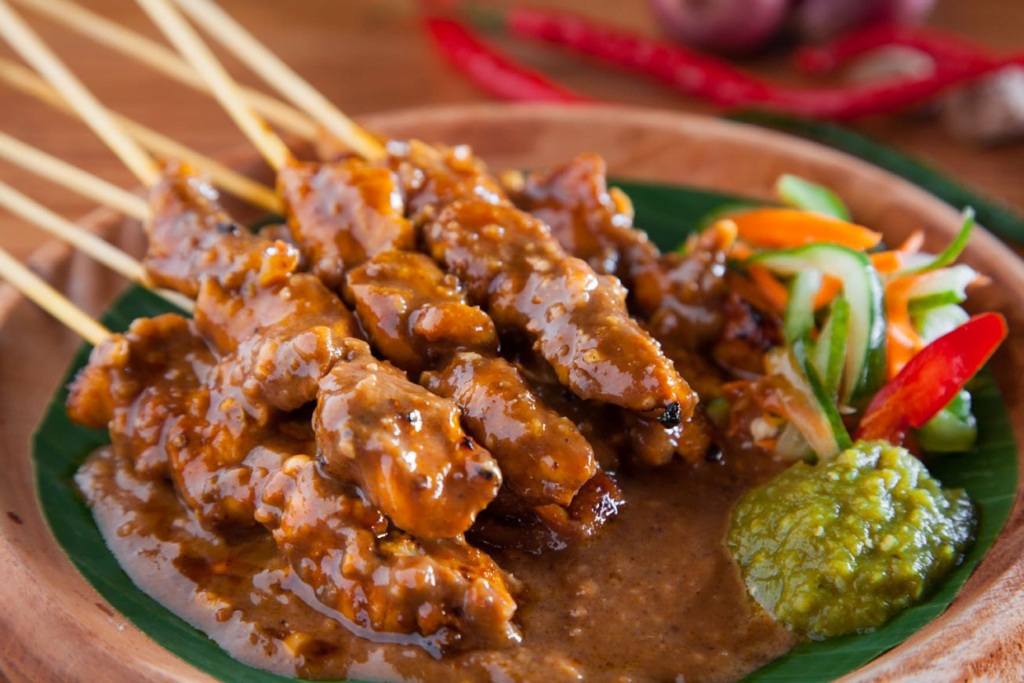
This classic Indonesian street food is a crowd-pleaser and a great option for grilling enthusiasts. The chicken is marinated in a flavorful blend of spices and coconut milk, then skewered and grilled to perfection. Serve with a side of peanut sauce and some steamed rice for a complete meal.
These are just some of the best Indonesian recipes to try at home. Don’t be afraid to experiment with different ingredients and spices to make them your own. With these authentic and delicious dishes, you’ll be able to experience the vibrant and diverse world of Indonesian cuisine right in your own kitchen.
Sate Ayam is also known as Chicken Satay, is a popular Indonesian dish that consists of skewered and grilled marinated chicken, served with a delicious peanut sauce. This dish is a favorite street food in Indonesia and is also commonly found in other Southeast Asian countries. Sate Ayam is known for its tender, flavorful chicken, often accompanied by a slightly sweet and savory peanut sauce. It is typically served with rice cakes (ketupat), cucumber, and shallot slices.
Indonesian Cuisine recipes – Sate Ayam Ingredients
Note: This recipe is for making Chicken Satay for four servings.
For the Chicken Satay
- 1 pound (450g) boneless, skinless chicken thighs or chicken breast, cut into bite-sized pieces
- Wooden skewers, soaked in water for at least 30 minutes to prevent burning
- 2 tablespoons vegetable oil, for brushing
For the Marinade
- 2 cloves garlic, minced
- 1 shallot, finely chopped
- 1 lemongrass stalk, white part only, finely chopped
- 1 teaspoon ground coriander
- 1 teaspoon ground cumin
- 1 teaspoon turmeric powder
- 1 tablespoon sweet soy sauce (kecap manis)
- 1 tablespoon soy sauce
- 1 tablespoon brown sugar
- 1 tablespoon vegetable oil
The Peanut Sauce (Sate Sauce)
- 1 cup unsalted roasted peanuts
- 2 cloves garlic
- 2 red chilies, deseeded (adjust to your spice preference)
- 1 teaspoon tamarind paste or juice from 1 lime
- 2 tablespoons palm sugar or brown sugar
- 1/2 cup coconut milk
- 1/2 cup water
- Salt, to taste
For Serving
- Rice cakes (ketupat), cucumber slices, and shallot slices
Indonesian Cuisine recipes – Sate Ayam Instructions
Prepare the Marinade
- In a food processor or blender, combine minced garlic, chopped shallot, lemongrass, ground coriander, ground cumin, turmeric powder, sweet soy sauce (kecap manis), soy sauce, brown sugar, and vegetable oil. Blend until you have a smooth paste.
Marinate the Chicken
- Place the chicken pieces in a bowl and coat them with the marinade. Make sure each piece is well coated. Cover the bowl and let the chicken marinate for at least 1 hour in the refrigerator, but longer for more flavor (overnight is ideal).
Prepare the Peanut Sauce
- In a food processor, blend the roasted peanuts until they form a fine powder or paste. Set aside.
- In the same food processor, combine garlic, red chilies, tamarind paste (or lime juice), palm sugar (or brown sugar), coconut milk, and water. Blend until you have a smooth sauce.
- Transfer the sauce to a saucepan and heat it over low to medium heat. Stir in the ground peanuts and cook for about 5-7 minutes until the sauce thickens. Season with salt to taste and remove from heat.
Assemble the Chicken Satay
- Thread the marinated chicken pieces onto the soaked wooden skewers. Be sure to leave some space at the bottom of each skewer for easy handling.
- Brush the chicken skewers with a bit of vegetable oil to prevent sticking on the grill.
- Preheat your grill to medium-high heat. Grill the chicken skewers for about 2-3 minutes per side or until they are cooked through and have nice grill marks.
Serve
- Arrange the Chicken Satay on a serving platter. Serve with peanut sauce, rice cakes (ketupat), cucumber slices, and shallot slices. Optionally, you can serve it with a small bowl of additional peanut sauce for dipping.
Enjoy your delicious Sate Ayam with the aromatic peanut sauce and the accompaniments.
Sate Ayam is a beloved Indonesian dish that’s perfect for grilling and sharing with friends and family. The combination of tender chicken and flavorful peanut sauce makes it a crowd-pleaser.
Exploring Indonesian Cuisine for Street Food

Indonesia is renowned for its vibrant street food culture, with bustling markets and food carts serving up a variety of traditional Indonesian dishes. From the savory to the sweet, Indonesian street food offers a diverse range of flavors and textures that are sure to delight the taste buds.
One of the most iconic street foods in Indonesia is Martabak, a stuffed pancake that can be filled with a variety of ingredients such as cheese, chocolate, or meat. This sweet and savory snack is a true crowd-pleaser and is often enjoyed as a breakfast or late-night snack.
Another popular street food is Sate Ayam, grilled chicken skewers that are marinated in a flavorful blend of spices and served with peanut sauce for dipping. This dish is a staple in Indonesian households and is often enjoyed at family gatherings or special occasions.
If you’re looking for a hearty and satisfying meal, Soto Ayam is a must-try. This chicken soup is made with fragrant herbs and spices, rice noodles, and a boiled egg on top. It’s the perfect comfort food on a chilly day.
For those with a sweet tooth, consider trying Klepon, a traditional Indonesian snack made of glutinous rice flour filled with palm sugar and coated in shredded coconut. This dessert is often enjoyed as a mid-day snack or after dinner treat.
Overall, Indonesian street food is a delicious and affordable way to experience the diverse flavors of Indonesian cuisine. Whether you’re a food enthusiast or simply looking for a quick bite to eat, the traditional Indonesian Cuisine recipes found in the country’s bustling food markets are sure to leave you feeling satisfied and wanting more.
Conclusion
As I conclude our journey to discover Indonesian Cuisine recipes, I must admit that I am left with a newfound appreciation for the rich and diverse flavors of this culinary tradition. From the aromatic spices to the unique cooking techniques, Indonesian Cuisine recipes, truly offers a tantalizing adventure for any food enthusiast.
With the help of our exploration, you now have a better understanding of the cultural significance behind traditional Indonesian dishes and the importance of rice in Indonesian cuisine. You have been introduced to some of the best Indonesian Cuisine recipes, both traditional and street food, which you can try at home and savor the authentic flavors.
Indonesian cuisine is undoubtedly a treasure trove of culinary delights, and it is my sincere hope that this journey has piqued your curiosity to try new flavors and embark on your own adventure through Indonesian cuisine and recipes.
So why not start your journey today and create a delicious Indonesian meal for yourself and your loved ones? Who knows, you may discover your new favorite cuisine!
FAQ’s
What are Indonesian Cuisine recipes – known for?
Indonesian cuisine is known for its rich flavors, diverse ingredients, and vibrant spices. It combines influences from various regions and cultures, resulting in a unique and delicious culinary experience.
What are some traditional Indonesian dishes?
Some traditional Indonesian dishes include Nasi Goreng (fried rice), Rendang (spicy beef stew), Satay (grilled skewers), Gado-Gado (Indonesian salad), and Soto Ayam (chicken soup).
Indonesian Cuisine Recipes?
Indonesian cuisine recipes offer a rich blend of flavors and spices, making them popular worldwide. From the fiery rendang to the savory nasi goreng, these recipes showcase the diverse culinary heritage of Indonesia.
Whether you’re a fan of spicy or mild dishes, exploring Indonesian cuisine is a delightful culinary adventure.
Indonesia National Food
Indonesia’s national food is nasi goreng, a delicious fried rice dish. This popular Indonesian staple is made with cooked rice stir-fried with various ingredients such as vegetables, meat, and spices.
Nasi goreng is known for its rich flavors and is often enjoyed for breakfast, lunch, or dinner throughout the country.
What are the key ingredients used in Indonesian cuisine?
Key ingredients used in Indonesian cuisine include spices such as turmeric, lemongrass, and galangal, as well as coconut milk, chili peppers, and tamarind. These ingredients contribute to the bold and aromatic flavors that are characteristic of Indonesian dishes.
Are Indonesian Cuisine recipes difficult to prepare?
While some Indonesian recipes may require specific ingredients or techniques, many dishes can be prepared at home with readily available ingredients. With step-by-step instructions and tips, you can recreate the flavors of authentic Indonesian cuisine in your own kitchen.
What is Indonesian street food like?
Indonesian street food is a vibrant and diverse culinary experience. From savory snacks like Martabak and Bakso (meatball soup) to sweet treats like Es Cendol (coconut milk dessert), Indonesian street food offers a wide range of flavors and textures.

